Japanese kitchen knives come in many types tailored to specific uses, especially when it comes to preparing fish.
In this guide, we focus on sashimi knives (yanagiba) – the long, sword-like Japanese knives used for slicing raw fish for sashimi and sushi. A yanagiba (often called a sashimi knife or sushi knife) has an elegant, katana-like beauty and is prized for making clean cuts of fish.
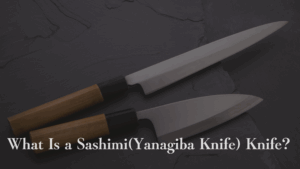
Below, we’ll first explain how to choose the best sashimi knife for your needs (with key points for both beginners and professional chefs). Then we’ll introduce our top recommended sashimi knives in a ranked list, including options for everyone from complete beginners to experienced sushi chefs.
Whether you’re searching for the best sushi knife to use at home or the best yanagiba knife for professional work, this guide will help you find the right blade.
How to Choose a Sashimi Knife (Yanagiba): Key Points
When choosing a sashimi knife, the considerations can differ for beginners versus professionals. Below we break down the important factors for each:
Important Points for Beginners
For those new to using a yanagiba, here are the main points to consider. (We’ll explain blade steel types in more detail after the table.)
| Point | Examples | Benefits (Pros) | Cautions (Cons) |
|---|---|---|---|
| Blade Material (Steel type) | – Stainless steel– Stainless composite (e.g. soft stainless cladding over hard core)– Carbon steel (e.g. White #2, Blue #2) | – Stainless is rust-resistant and easy to maintain.– Carbon steel offers superior sharpness.– Warikomi (san-mai clad) knives combine a hard carbon core (sharp edge) with stainless exterior for rust resistance and easier care. | – Carbon steel rusts easily, requiring diligent wiping and frequent sharpening.– Even clad knives with a carbon core need the exposed edge portion kept dry to prevent rust.– Sharpening skills/technique need to be learned (especially for carbon steel). |
| Blade Length | – Depends on intended use (see length guide below) | – A medium length (not too long or short) fits on a typical home cutting board and is easier to handle. | – Longer blades can be harder to control. If you’re a beginner, starting a bit shorter (around 240 mm (~9.5″)) can be advisable. |
| Price Range | – Around ¥10,000–¥20,000 (approx. $100–$200 USD) | – This range generally ensures a certain level of quality, with good sharpness and durability. | – If a knife is too cheap, it may lack adequate sharpness or durability. Invest in a trusted brand to avoid disappointment. |
| Handle(Grip design) | – Wa-style handle (traditional Japanese handle), e.g. octagonal or round shape. | – Choosing a handle shape/material that fits your hand well reduces fatigue and makes the knife easier to control. | – It’s hard to judge fit without actually holding it. Everyone’s grip preference is different, so what feels right can vary. |
| Weight | – Light to medium weight is typical. | – A slightly lighter knife is easier for beginners to handle and less tiring to use. | – Extremely light knives might lack stability. A bit of heft can actually help steady the knife during slicing. |
| Sharpening (Maintenance) | – Plan on sharpening about once a month with a whetstone. | – Keeping the knife sharp ensures you can slice fish cleanly without crushing the flesh, resulting in beautiful sashimi. | – You’ll need to learn how to sharpen according to the knife’s material and how often it’s used. Single-bevel blades (kataba) can be trickier to sharpen due to their asymmetry. |
After choosing a knife, consider what blade length suits your needs. The appropriate blade length for a yanagiba depends on the size of fish and your workspace. Here’s a quick guide to lengths and their best uses:
| Blade Length (approx.) | Suitable Uses & Characteristics | Pros & Cons (Notes) |
|---|---|---|
| ~210 mm (8″) | – Small fish; making small sashimi slices.– Good for tight spaces or small home cutting boards. | – Easiest to handle; great for beginners. – Con: A bit short for slicing larger fish in one stroke (may require multiple pulls). |
| ~240 mm (9.5″) | – Medium fish (e.g. half fillet of seabream, snapper).– Most popular length for general home sashimi preparation. | – Versatile and reasonably easy to handle. Can tackle most household sashimi tasks.– Can even manage some larger fish or more advanced slicing techniques. |
| ~270 mm (10.5″) | – Medium-to-large fish (e.g. yellowtail, salmon fillets).– Common among experienced home cooks and some pros. | – Allows for a full slicing motion through larger pieces, yielding clean, professional-looking cuts.– Con: Requires a bit more space and skill to use effectively. |
| ~300 mm (12″) | – Large fish (e.g. big cuts of tuna, amberjack).– Often used by sushi chefs and in professional Japanese kitchens. | – Can slice through a long piece of fish in a single draw, minimizing sawing and preserving presentation.– Con: Needs a larger cutting surface and good technique; overkill for small home kitchens. |
| ~330 mm (13″) | – Very large fish or tuna/amberjack loins (saku blocks).– Primarily seen in high-end sushi bars and traditional restaurants. | – Extremely long draw cuts produce immaculate slices from large fish. Impressive capability in skilled hands.– Con: Demands significant experience and ample space; not practical for typical home use. |
| ~360 mm (14″) | – Specialty use (tuna carving shows, very large fillets).– Used by only the most experienced for specific tasks. | – Can handle huge fish with ease in expert hands.– Con: Impractical for normal kitchens – requires expert skill and is very expensive. |
Blade Materials: In general, carbon steel vs. stainless steel is a key decision. Carbon steels (like the White and Blue paper steels from Hitachi) offer extremely sharp edges, but they will rust if not cared for, meaning you must clean and dry them diligently.
Stainless steels resist rust far better, though often at a slight cost to ultimate sharpness (some high-end stainless alloys, however, are exceptionally sharp too).
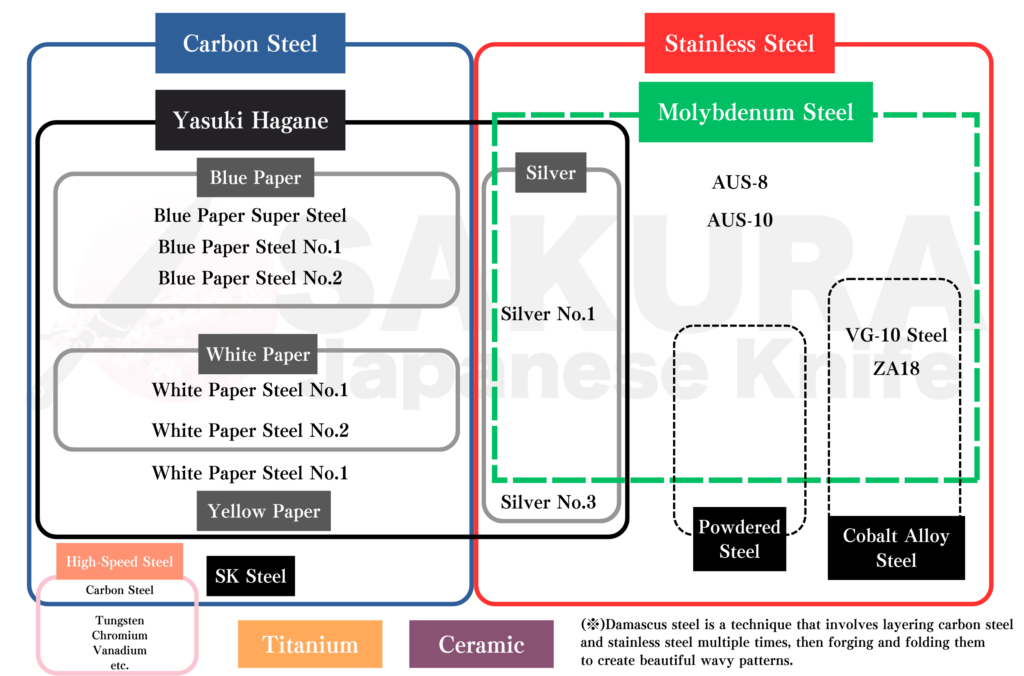
For beginners, stainless or semi-stainless options can be a smart choice – for instance, Ginsan (Silver #3) or VG10 stainless blades provide very good sharpness with much easier upkeep (no constant worrying about rust).
If you want the cutting feel of carbon steel but a bit less maintenance, consider a laminated blade (e.g. a knife with a hard carbon steel core and softer stainless cladding) or other warikomi styles. These give you some of the sharpness of carbon steel at the edge, with a stainless outer layer for added rust resistance.
Important Points for Professionals
If you’re a professional chef or an experienced user, you’ll likely prioritize different factors:
- Uncompromising sharpness – In professional sushi and kaiseki, the beauty of the slice matters. The knife must make perfectly clean cuts to preserve texture and flavor.
- Longer, heavier blades – Pros often use longer yanagibas (270–330 mm or more) to handle larger fish and make long draw cuts. A bit of weight can add stability and momentum in cutting.
- Frequent use & maintenance – Since the knife will see heavy daily use, you need to be prepared for daily upkeep (cleaning, drying, honing). Edge retention is crucial, but so is the ability to resharpen effectively during busy prep sessions.
Key selection points for professionals are summarized in the table below:
| Point | Examples (for Pros) | Benefits (Pros) | Cautions (Cons) |
|---|---|---|---|
| Blade Material (Steel) | – High-carbon steel (e.g. White #2, Blue #2)– Honyaki (full carbon steel, single-forged)– Laminated or semi-stainless (e.g. Ginsan steel, stainless-clad blades) | – High-carbon steels and honyaki blades excel in ultimate sharpness – the edge quality is unparalleled when properly honed.– Laminated blades (e.g. stainless-clad) offer a balance of sharpness and rust resistance, requiring less fuss in a busy kitchen. | – Carbon steel will rust without careful upkeep; you must wipe moisture immediately and oil as needed.– Honyaki knives are very expensive and can be harder to sharpen (extremely hard steel).– In a hectic environment, you need to balance peak sharpness with practical maintainability. |
| Blade Length | – Generally 270 mm and up (sometimes 300 mm+). | – A longer blade makes it easier to slice large fish or thick fillets in one go, improving speed and slice quality. | – Very long blades require skilled handling and enough workspace. A cramped station can make using a 330 mm yanagiba difficult (and potentially dangerous). |
| Price Range | – Approximately ¥30,000–¥100,000+ (about $300–$1,000+ USD, especially for famed makers or honyaki models). | – At this level, you’re paying for top-notch steel and master craftsmanship, resulting in superb sharpness and durability. Designed to last decades. | – It’s an investment – pricey knives demand care (risk of theft or damage in busy kitchens).– If you’re not experienced in choosing and maintaining knives, you might not fully utilize the knife’s performance (or could even damage it). |
| Handle | – Octagonal, oval, or custom wa-handle (often hardwoods like ebony, walnut, or magnolia with buffalo horn ferrule). | – You can pick a handle shape/size that suits your grip perfectly, reducing fatigue during long prep sessions.– High-end or custom handles also provide a sense of ownership pride and motivation. | – Without trying it in hand, it’s hard to know if a handle truly fits you. If you work in wet environments, wooden handles can require care (they can mold or deteriorate if neglected). |
| Weight | – Medium to slightly heavy weight preferred. | – A bit of heft adds stability for smooth slicing in professional settings. The knife “falls” through the fish with less effort, making for cleaner cuts. | – Too heavy can strain your wrist or elbow, especially over long hours. If you have many hours of slicing, even moderate extra weight can lead to fatigue. |
| Maintenance | – Daily routine: wipe down moisture after each use.– Regular honing/sharpening with proper whetstones (coarse->medium->fine as needed). | – By keeping the edge in top condition, you ensure the quality, speed, and safety of your sashimi work. A razor-sharp knife means fish flesh stays pristine with each cut. | – High-carbon and honyaki knives require immediate cleaning and drying after use to prevent rust. In a busy kitchen, you must still find time to care for the blade.– If you can’t regularly sharpen or strop, even the best knife’s performance will drop. |
| Sharpening | – Use proper sharpening stones (coarse, medium, fine grit).– Sharpen at the correct angle (single-bevel blades require specialized technique). | – Mastering sharpening allows you to optimize the knife’s edge for ultra-fine cuts, bringing out the best in high-end knives. You can achieve the delicate, precise cuts that professionals strive for. | – It takes practice to learn precise sharpening, especially for single-bevel yanagibas (to maintain the flat back and correct bevel angle).– In a restaurant setting, finding time to sharpen can be tough – if you skip it, the knife’s performance will suffer. |
| Origin & Brand | – Traditional knife-making regions like Sakai (Osaka), Seki (Gifu), Sanjo (Niigata), Tosa (Kochi), etc. | – Each region or blacksmith has their style – choosing a renowned brand or craftsman can mean superb fit and finish, and often a particular feel to the knife (profile, weight balance, etc.). Owning a knife from a famous maker carries prestige and personal satisfaction. | – Top brand knives tend to be more expensive. Some famous smiths have long wait times or limited availability. Also, high-end knives might set high expectations for care and use – as a chef, you need to live up to the tool. |
Now that we’ve covered what to look for, let’s dive into the actual knives. Below we’ve compiled the best sashimi knives for both beginners and professionals. (We’ve separated the list into two sections:
beginner-friendly picks and pro-level picks.) The ranking is a general guide – all these knives are excellent in their own ways, so consider your own needs (steel type, length, maintenance) when making a choice.
Best Sashimi Knives for Beginners (Yanagiba)
First, here are our top recommended sashimi knives for beginners. These knives emphasize ease of use and maintenance while still providing the sharpness needed for beautiful sashimi.
(If you’re a professional, you can skip ahead to the Pro Picks section for higher-end yanagibas.)
Hashimoto Mikizō Ryōba Sashimi Knife (Double-Bevel)
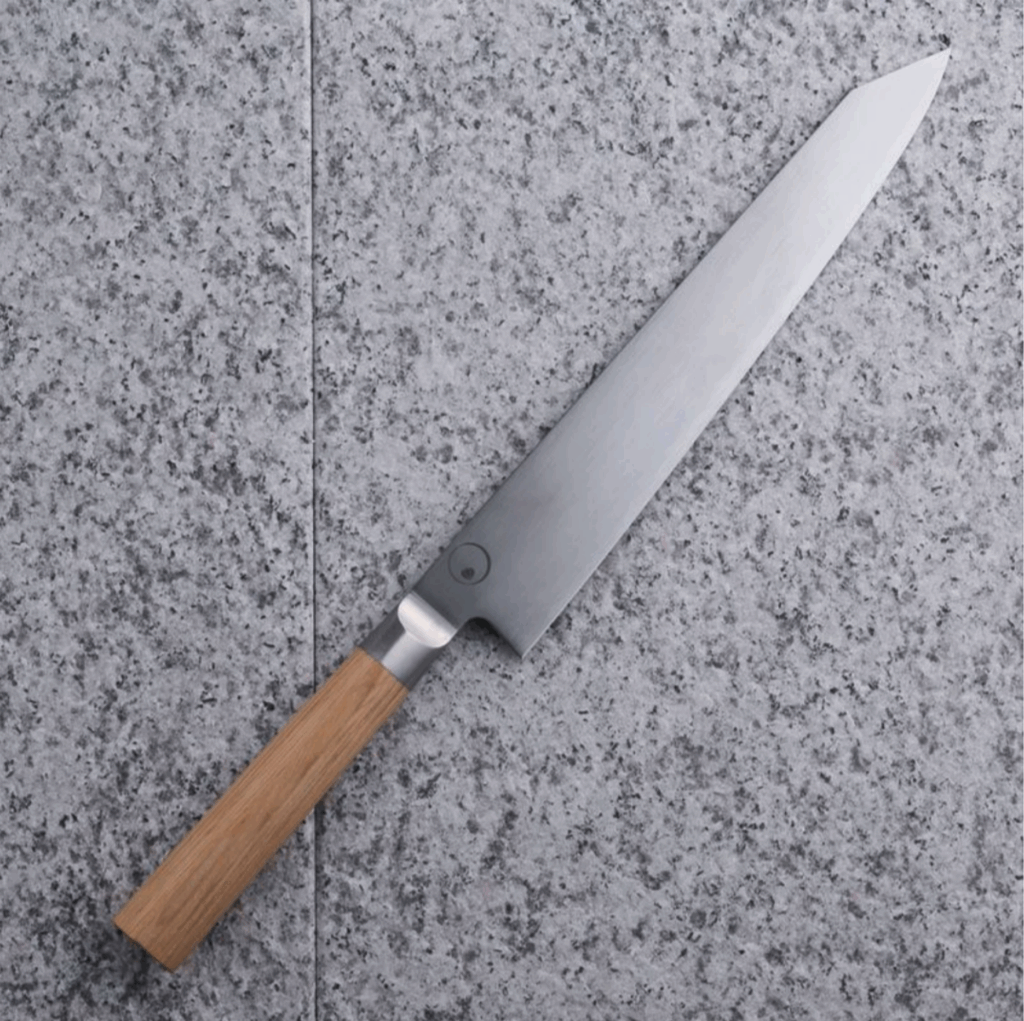
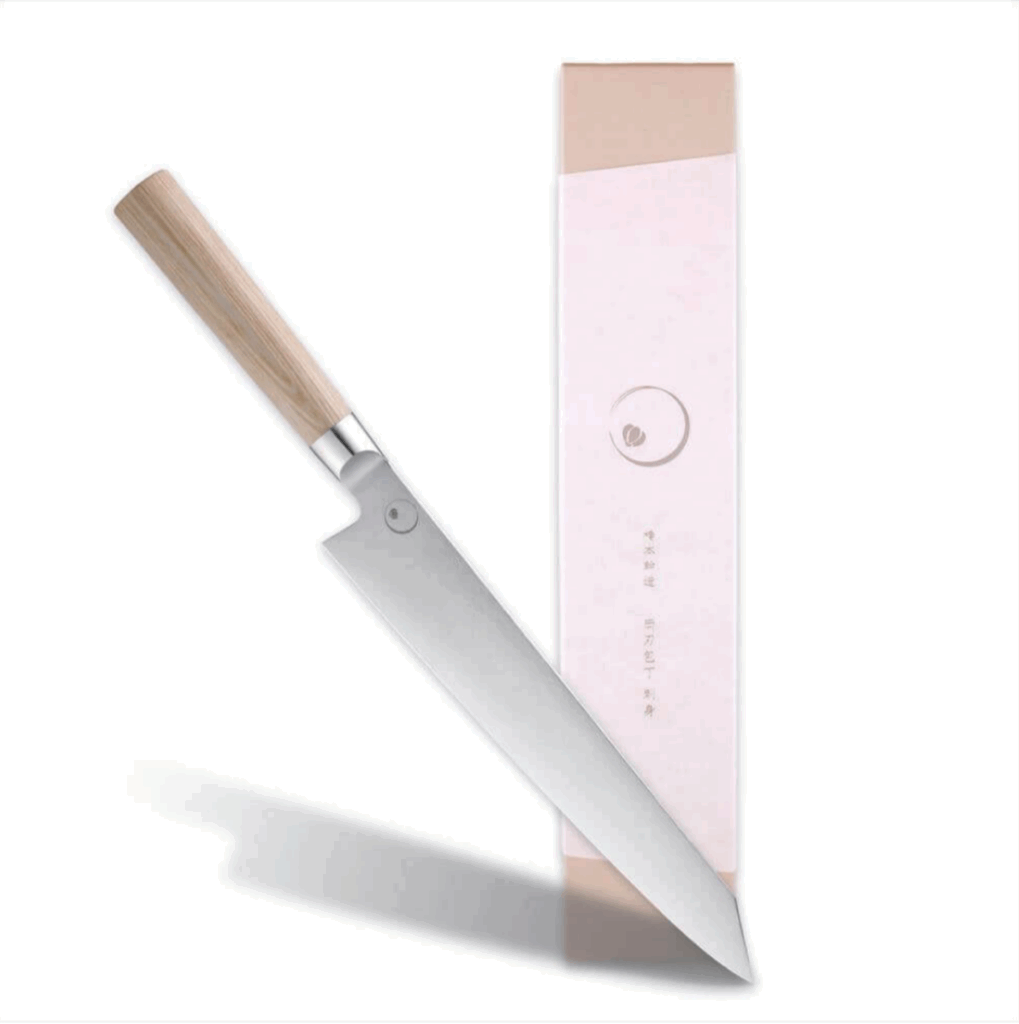
| Aspect & 5-Point Rating | Notes & Key Points |
|---|---|
| Sharpness ★★★☆☆ | Out of the box, this knife is plenty sharp for sashimi. It uses a high-quality high-carbon stainless steel core, and each knife is honed by craftsmen under master Hashimoto Mikizō’s supervision. The thin double-bevel edge glides through fish with minimal resistance, giving clean cuts. |
| Edge Retention ★★★★☆ | The high-carbon stainless blade (≈ HRC 58) keeps its edge through many slicing sessions before needing a touch-up. It’s a bit softer than full-carbon steels like White #2, so it chips less while still holding sharpness well for home use. |
| Rust Resistance ★★★★★ | Fully stainless construction (core and cladding) offers excellent corrosion protection—ideal for a knife that often meets raw fish and moisture. Wash and dry after use and rust spots are rarely a concern. |
| Maintenance ★★★★☆ | A double-bevel edge is far easier to sharpen evenly than a single-bevel yanagiba. Because it holds an edge and resists rust, upkeep is minimal: wash, dry, and occasional sharpening. No special oiling required. |
| Aesthetics ★★★☆☆ | Clean, sleek lines with a kiretsuke-style tip evoke a subtle katana vibe. A fine satin blade finish contrasts nicely with the stainless bolster and dark-brown pakkawood handle for a refined, understated look. |
| Price | $165 USD |
Our #1 pick for beginners is the “Hashimoto Mikizō Ryōba Sashimi” knife, offered by KAI (the company famous for the Sekimagoroku brand).
Most traditional wa-bocho (Japanese knives) are single-bevel, but the Hashimoto Mikizō sashimi knife is unique in that it’s double-beveled. This makes it significantly easier for beginners to handle, since it cuts without steering to one side and sharpens like a normal knife.
The blade steel is a high-carbon stainless, which strikes a great balance for newcomers: it’s rust-resistant and fairly hard, providing more than enough sharpness for home sushi and sashimi preparation.
While pure carbon steels or powdered high-speed steels (like some pro knives use) can achieve a sharper edge, this knife’s edge is still very keen – plenty sharp for home use – and far less prone to rust. It’s also easier to sharpen than most fully stainless knives, making maintenance more beginner-friendly. The affordable price point is another attractive feature for those buying their first sashimi knife.
Customer Feedback (Female, 30s): “I was first drawn to its simple and sophisticated design. I like my kitchen tools to look stylish, and this knife’s clean, minimalist appearance fits into any kitchen decor. The handle has a solid shape that is non-slip and feels very comfortable in my grip – a big plus.”
Customer Feedback (Female, 40s): “With its easy-to-grip handle and simple design, maintenance is a breeze. Even as a beginner, I can produce clean, professional-looking slices with ease, and preparing sashimi at home has become so much more fun. It’s my go-to when entertaining family or friends – it really elevates the presentation!”
KEEMAKE Sashimi Yanagiba Knife 295 mm (VG10 Stainless)

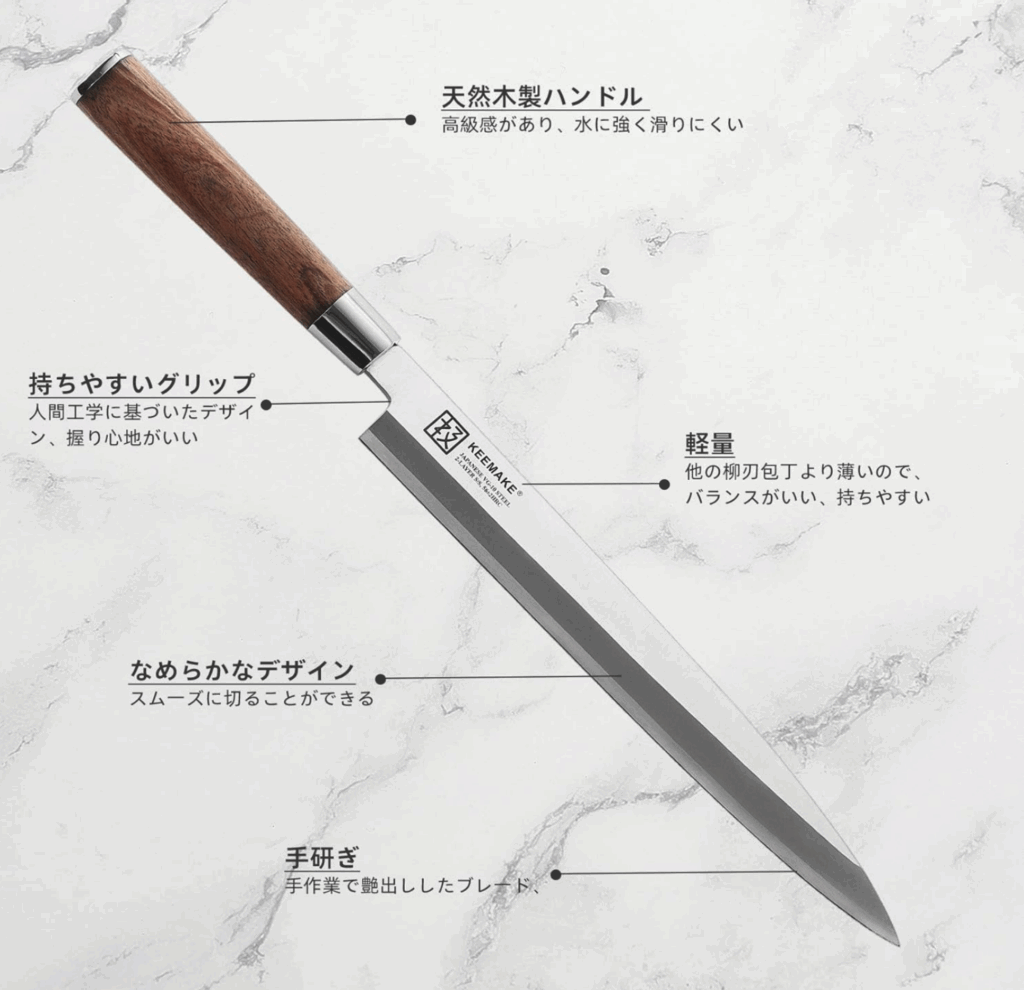
| Aspect & 5-Point Rating | Notes & Key Points |
|---|---|
| Sharpness ★★★☆☆ | Out of the box, this knife is plenty sharp for sashimi. It uses a high-quality high-carbon stainless steel core, and each knife is honed by craftsmen under master Hashimoto Mikizō’s supervision. The thin double-bevel edge glides through fish with minimal resistance, giving clean cuts. |
| Edge Retention ★★★★☆ | The high-carbon stainless blade (≈ HRC 58) keeps its edge through many slicing sessions before needing a touch-up. It’s a bit softer than full-carbon steels like White #2, so it chips less while still holding sharpness well for home use. |
| Rust Resistance ★★★★★ | Fully stainless construction (core and cladding) offers excellent corrosion protection—ideal for a knife that often meets raw fish and moisture. Wash and dry after use and rust spots are rarely a concern. |
| Maintenance ★★★★☆ | A double-bevel edge is far easier to sharpen evenly than a single-bevel yanagiba. Because it holds an edge and resists rust, upkeep is minimal: wash, dry, and occasional sharpening. No special oiling required. |
| Aesthetics ★★★☆☆ | Clean, sleek lines with a kiretsuke-style tip evoke a subtle katana vibe. A fine satin blade finish contrasts nicely with the stainless bolster and dark-brown pakkawood handle for a refined, understated look. |
| Price | $165 USD |
Our #2 pick is the KEEMAKE Yanagiba Sashimi Knife.
KEEMAKE is a brand that manages to keep costs down by manufacturing in Yangjiang, China – one of the world’s major knife-producing regions – while incorporating Japanese-style blade finishing and sharpening techniques.
The blade material is VG10 stainless steel, which offers more than enough cutting performance for home use. VG10 is one of the top stainless steels used in Japanese knives, known for excellent sharpness and edge retention along with good rust resistance.
In practical terms, this means the knife delivers razor-sharp cuts and stays sharp longer, with the big advantage of being far less rust-prone than carbon steel. Because KEEMAKE produces knives in large volume, the price is very budget-friendly – making it a great “first sashimi knife” for beginners.
Customer Feedback (Female, 20s): “Even though the KEEMAKE sashimi knife is stainless, the sharpness is excellent and it’s super rust-resistant and easy to care for. The long yanagiba blade slides through fish fillets effortlessly, and the slices come out beautifully clean. The handle feels just right in my hand, and I can easily create restaurant-quality sashimi at home.”
Customer Feedback (Male, 30s): “The lasting sharpness is amazing. Thanks to the VG10 steel, it’s virtually rust-proof and maintenance is simple. The long blade lets me slice smoothly, and it really elevates the presentation – I feel like I’m at a fine Japanese restaurant! The edge just keeps going and going, which is the best part.”
(Now, let’s move on to our top sashimi knife picks for professional use.)
Best Sashimi Knives for Professionals (Yanagiba) – Top Ranked Picks
Next, we present the recommended sashimi knives for professional chefs or experienced users, in a ranked format. We’ve given them a ranking, but honestly all of these are stellar knives – you really can’t go wrong with any of them. Consider the steel and features that suit your work best when choosing.

(The rankings are just a guideline; each knife here is top-tier, so pick according to your personal preferences and needs.)
1st Place: Sakai Takayuki “Genbu” Yanagiba 300 mm (Blue #2 Steel)

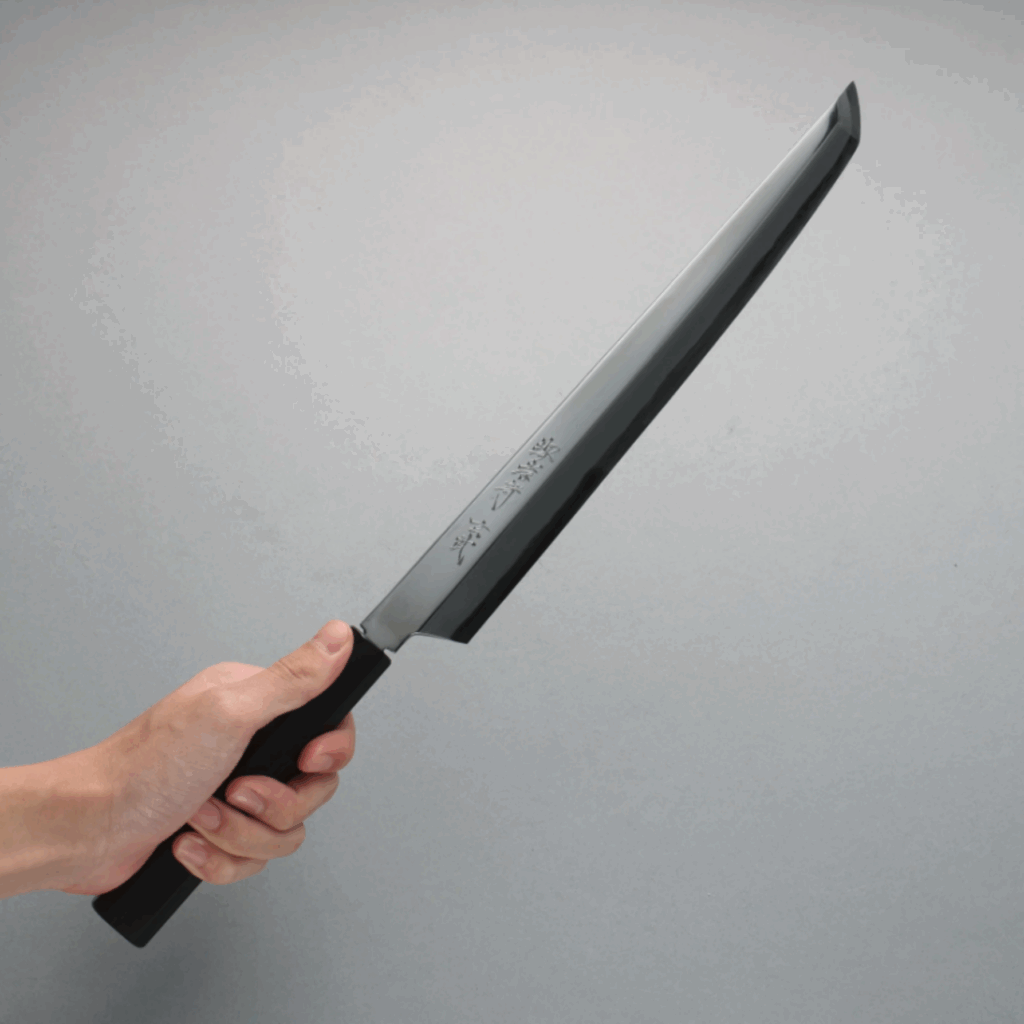
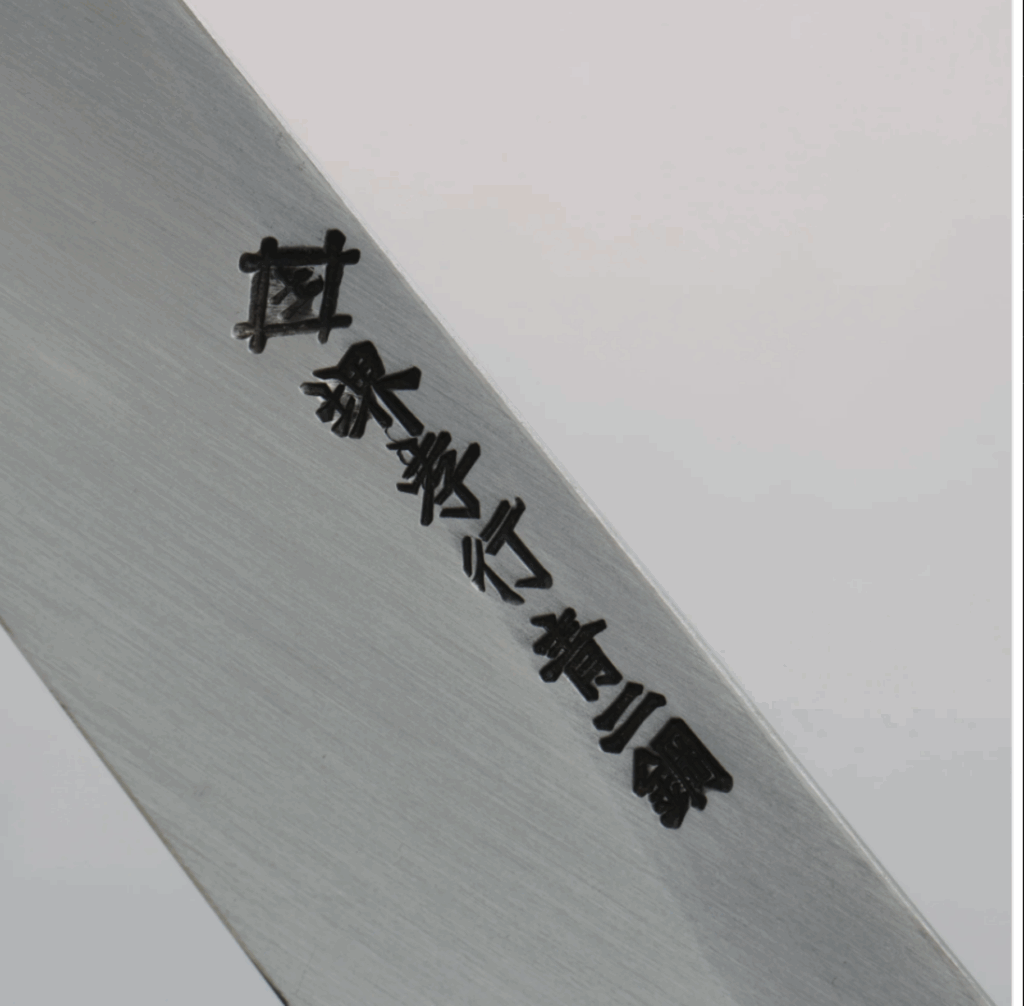
| Aspect & 5-Point Rating | Notes & Key Points |
|---|---|
| Sharpness ★★★★★ | Blue #2 steel core is honed to a professional honbazuke edge, giving razor-like keenness. Fish fibers are sliced cleanly with almost no force, so one smooth pull yields glass-smooth sashimi surfaces. |
| Edge Retention ★★★★☆ | Blue #2 (≈ HRC 61–62) plus tungsten delivers excellent wear resistance; sharpness lasts through long prep sessions without mid-shift touch-ups—ideal for pro kitchens handling large fish volumes. |
| Rust Resistance ★★☆☆☆ | High-carbon steel means low corrosion resistance; the blade will rust if left wet. Immediate wash-and-dry is mandatory after cutting raw fish. Mirror polish helps cleanup, but vigilance is essential. |
| Maintenance ★★☆☆☆ | Needs periodic stone work to stay at peak, though Blue #2 responds well to medium/fine grits. Avoid soaking the ebony handle; an occasional coat of camellia oil keeps it healthy. Extra care is rewarded with elite performance. |
| Aesthetics ★★★☆☆ | Mirror-polished sakimaru blade, octagonal ebony handle, and jet-black lacquered saya give it art-piece allure—sure to draw praise from fellow chefs and collectors alike. |
| Price | USD1000 |
The Sakai Takayuki “Genbu” is a sashimi knife that uses a Blue Paper #2 steel core and features a painstaking mirror finish on the blade.
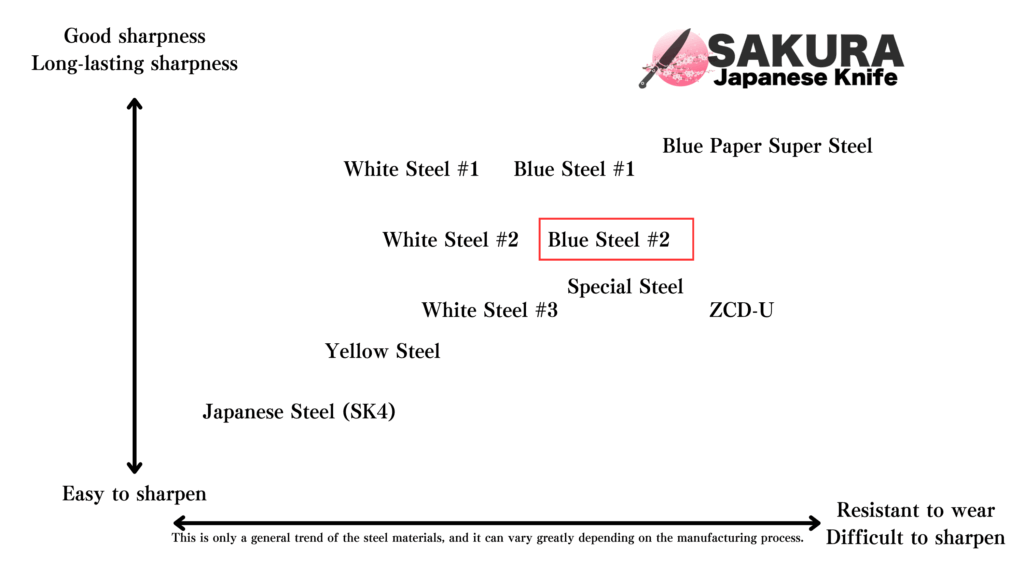
Blue #2 is a carbon steel alloyed with tungsten, known for achieving a high degree of sharpness and wear resistance simultaneously. Skilled artisans at Sakai Takayuki forge and polish the blade through multiple steps until it literally reflects like a mirror.
This mirror finish isn’t just for looks – it also reduces friction as the blade moves through fish, resulting in an incredibly smooth slicing action that leaves fish flesh unblemished and glossy. The Blue #2 steel is hardened to about HRC 61–62, which is extremely hard by professional standards, yet it isn’t as brittle or difficult to sharpen as something like Blue Super.
That means once you sharpen it, the edge stays razor-sharp for a long time, but when it does need touching up, it still responds well to whetstones. This makes Blue #2 a favorite among many chefs for balancing sharpness, toughness, and ease of maintenance (relative to its hardness).
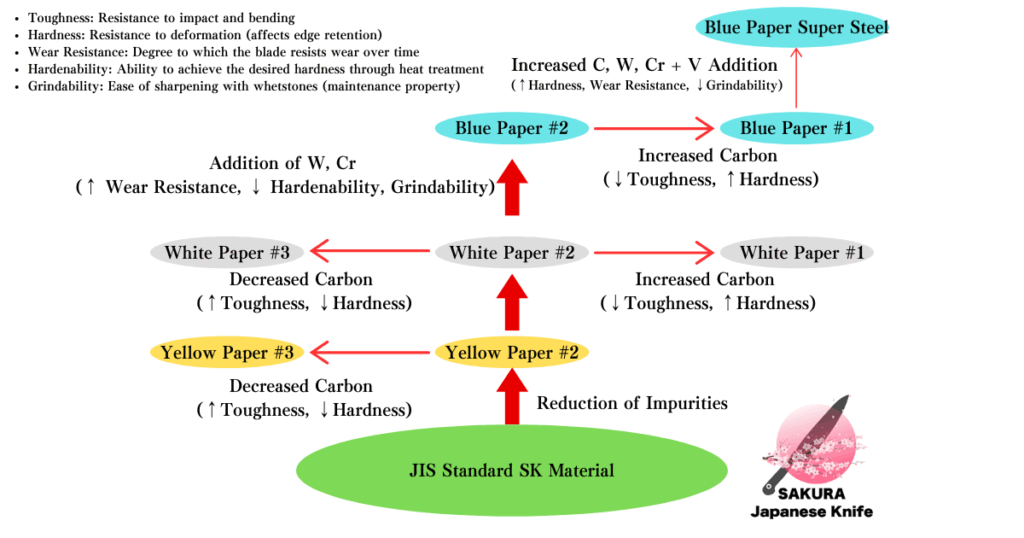
Another design highlight: the Genbu uses a sakimaru yanagiba shape (sometimes called sakimaru takobiki), which has a rounded tip.
This design enables very smooth pull cuts (you can draw the knife back in one go without the tip digging into the cutting board), and it reduces damage to the tip when it contacts the board. The blade is also slightly wider than a standard yanagiba, which adds stability when lifting sliced fish or doing usuzukuri (ultra-thin slices) – it’s a feature appreciated in professional settings.
The handle is made from octagonal ebony wood with a water-buffalo horn bolster (ferrule). This combination not only looks high-end but also provides an excellent balance with the blade’s weight, reducing wrist fatigue even during prolonged sashimi prep.
The weighty ebony handle complements the blade, so the knife feels well-balanced in hand. Of course, being a carbon steel knife, it’s not very rust-resistant – you must diligently wipe off any moisture or salt after use. The mirror finish will show fingerprints and stains easily, so you’ll find yourself keeping it clean as you work. But for the professional willing to upkeep it, this knife delivers performance and beauty that are absolutely worth it.
Professional Review – Sushi Chef (Edomae style, 10+ years experience): “When I first held the Genbu yanagiba after over a decade behind the sushi counter, I was honestly blown away by how keen that edge was. As I draw it through a fish, the weight of the knife and the razor edge together allow it to slide in with almost no force. For example, even with a fatty tuna fillet, a single stroke through it meets no resistance, and the cut face shines like a mirror. Because it doesn’t crush the flesh at all, the texture of the sushi neta (topping) is vastly improved – customers often remark that today’s tuna is exceptional. The rounded tip is also very user-friendly, since I never worry about it poking into the board; I can work rhythmically. Even doing delicate tasks – like making paper-thin hirame (flounder) usuzukuri – this knife can produce uniformly transparent slices with ease, and I find myself admiring the beautiful cut surfaces that only a proper pull cut can create.”
Professional Review – Washoku Chef: “In a Japanese restaurant kitchen, slicing sashimi is just one part of the job, but this Genbu yanagiba has become a huge asset in my work. When I’m prepping seasonal sashimi platters at our ryotei (traditional restaurant), the Blue #2 blade shows incredibly stable sharpness – I can cut from morning through night and it barely seems to dull. For instance, even on days where I prepare sashimi for dozens of guests, the knife’s edge doesn’t fade until towards the very end, meaning I spend less time pausing to touch up on the stone and can focus on plating. Thanks to its long, wide blade, even tasks like slicing slightly thicker pieces (for something like kobujime cured white fish) are done in one sweep without the slice falling apart. And beyond sashimi, I even use it for things like slicing fish for saikyō-yaki (grilled miso-marinated Spanish mackerel) or shaving roast beef tataki into thin slices – any task requiring delicate, precise cuts. The mirror-finish blade glitters under the kitchen lights, and sometimes when I’m plating, a customer catches a glimpse and says, ‘That’s a beautiful knife,’ which sparks conversation. This Genbu truly helps me elevate my work in both performance and presentation.”
2nd Place: Sakai Jikkō “Gion Haku” Kiritsuke Sashimi Knife (White #2 Steel, 270 mm)
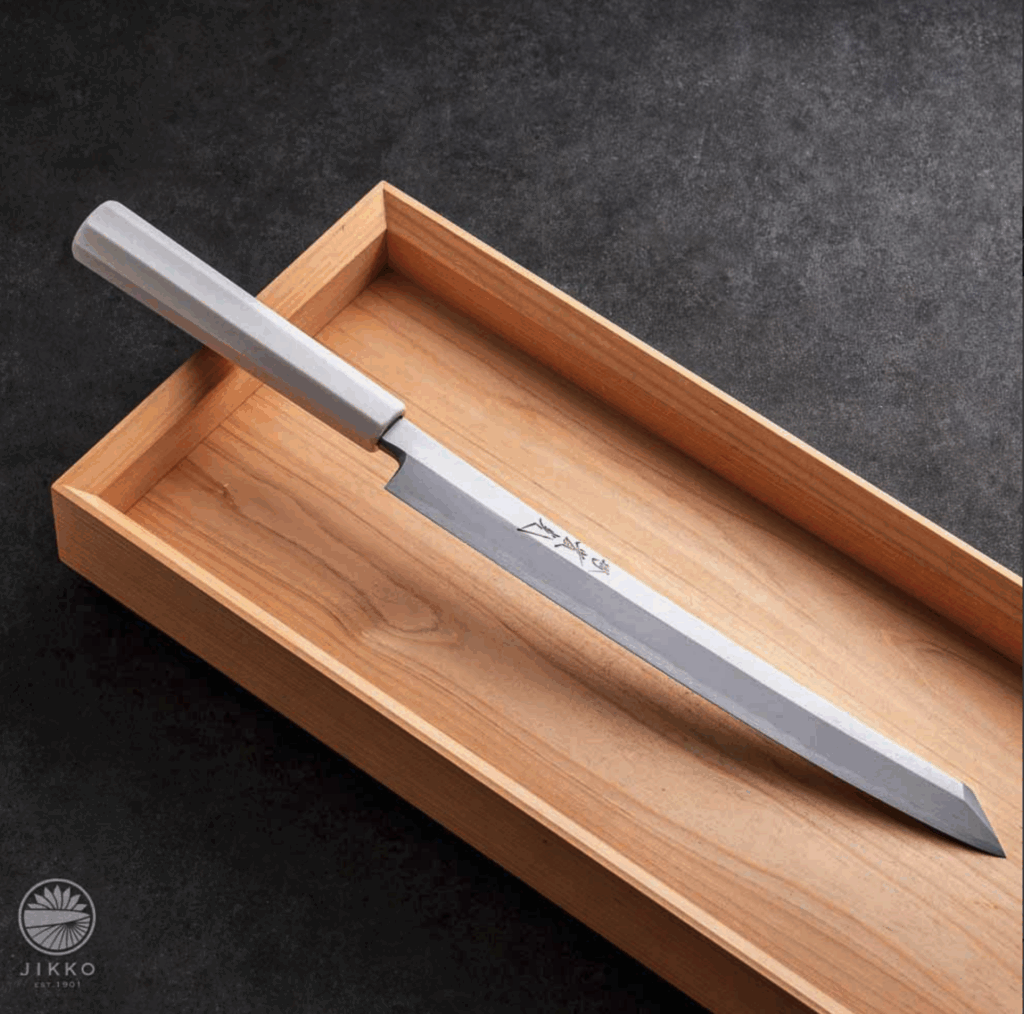



| Aspect & 5-Point Rating | Notes & Key Points |
|---|---|
| Sharpness ★★★★★ | White #2 steel has an exceptionally fine grain, and Sakai Jikkō’s honbazuke finish lets it reach a razor-like edge. Out of the box the Gion Haku glides through fish with surgical precision—ideal for sushi chefs demanding ultra-clean pull cuts. |
| Edge Retention ★★★☆☆ | White #2 favors absolute keenness over extreme longevity. Warikomi construction (hard core, softer cladding) adds toughness, so micro-chipping is rare, but you’ll refresh the edge a bit sooner than with Blue steel. Still holds up through a full service with no drama. |
| Rust Resistance ★☆☆☆☆ | Core and cladding are both high-carbon steel, so corrosion protection is virtually zero. Any moisture or fish juices left on the blade will cause rust fast. Meticulous wash-and-dry after every use is non-negotiable. |
| Maintenance ★★★★☆ | White #2 is famed for how easily it takes a screaming-sharp edge. Even light touch-ups on medium/fine stones restore peak performance, and the softer cladding adds durability. Sharpening is straightforward for anyone comfortable with whetstones. |
| Aesthetics ★★★★☆ | Striking “all-white” look: misty kasumi blade finish paired with a white pakkawood handle gives a modern monochrome vibe that still honors wa-knife tradition—often described as a “white katana.” Bold yet elegant. |
| Price | 240 mm USD560 270 mm USD620 300 mm USD750 330 mm USD940 |
Sakai Jikkō (實光刃物) is a long-established knife maker from Sakai City, Osaka, and the “Gion Haku” is one of their innovative models created at the request of chefs in the Gion district of Kyoto. Its most defining feature is its pure white aesthetic. T
he handle is bright white resin and the blade has a hazy kasumi polish that gives a silvery-white appearance – it truly looks like a “white Japanese sword.” The knife comes in a range of lengths from 240 mm up to 330 mm, and it has a kiritsuke (k-tip) blade shape* (called kiritsuke-gata or ken-gata yanagiba, meaning the tip is clipped to a sharp angle).
This kiritsuke style tip is designed to be very functional for sashimi slicing; it provides a pointed tip that’s great for initiating cuts and doing detail work, and many find it easier to maneuver than the more common pointed yanagiba (maguro-bocho style) in Kansai. It’s a slightly different feel that some chefs prefer for its handling.
The blade material is high-quality White Paper #2 steel (known as shirogami #2). White #2 is a very pure carbon steel with minimal impurities, famed for its exceptional sharpness and ease of sharpening.
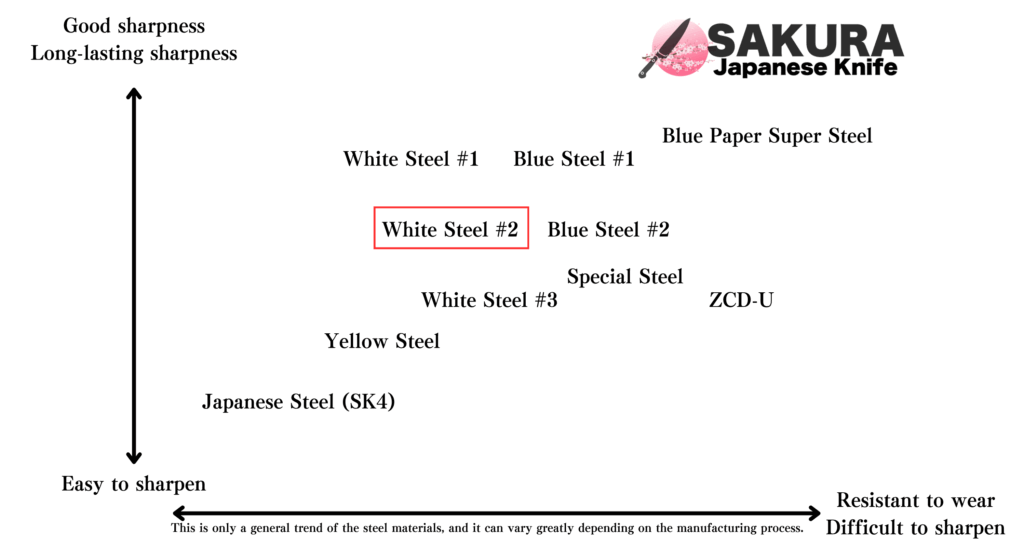
It’s one of the most popular steels in professional Japanese knives for exactly those reasons – many professionals consider White #2 the gold standard for a sharpenability/sharpness balance. In fact, it’s one of the most widely loved steels by sushi and washoku chefs.
White #2 is arguably the most popular carbon steel among professional sashimi chefs, often recommended as a go-to choice.
The Gion Haku’s blade is constructed with a hard White #2 core and soft iron cladding (kasumi construction). The kasumi polish brings out a gentle contrast between the shiny edge steel and the foggy matte iron, creating a faint hamon-like pattern.
It’s an incredibly beautiful effect – the blade has a subtle white mist pattern where the two metals meet. Because of the carbon steel core and cladding, rust prevention is critical: you have to immediately wash off any protein or acidic residue after cutting fish and dry the blade. The white handle and blade will show any discoloration, so meticulous care is a must to maintain its looks.
However, the performance of White #2 steel is top-notch: it takes an extremely keen edge and is very pleasant to sharpen.
Even if you’re not a seasoned sharpener, White #2 can be easier to touch up than many other steels, and thanks to the cladding, it’s forgiving and less brittle than a full honyaki.
It won’t chip easily and doesn’t require constant sharpening, which makes it a bit easier to handle in a busy environment compared to something like Blue Super. This knife’s design and steel make it something special – it merges traditional craftsmanship with a modern design flair, resulting in a functional piece of art.
Professional Review – Kyoto Cuisine Chef: “Whenever I take this ‘Gion Haku’ knife in hand as a Kyoto chef, I feel a bit of a special excitement. When the white wooden cutting board, white dishware, and this knife with a white handle all come together, it’s like looking at a harmonious scene from a painting. In that moment of slicing seasonal fish, alongside the focused tension, I also feel a calm joy. The actual cutting feel can only be described as the blade “sucking into” the fish – every time I make a cut it just glides right in. The kiritsuke-style pointed tip is surprisingly useful – whether I’m skinning a flounder fillet or making tiny decorative cuts, it’s like the sensitivity of my fingertips extends right through the tip of the knife. As a Kyoto chef, having a knife that feels this perfectly suited to my craft is inspiring; when plating sashimi, gripping that pure white handle, I find myself thinking ‘There might be no knife more fitting for a Kyoto chef.’ Sometimes customers even comment, ‘This sashimi seems special somehow,’ and I secretly believe it’s thanks to this knife.”
Professional Review – Sushi Chef: “When I first picked up the ‘Gion Haku’ kiritsuke yanagiba, to be honest I was blown away by the white handle and misty blade pattern. It has a serene beauty, almost like a Noh mask – just looking at it made me stand up straighter. In actual use, slicing hirame (flounder) with it, the sharpness of the White steel exceeded my expectations – each slice of usuzukuri came out translucent. Also, the aggressively pointed ken-tip turned out to be incredibly handy; whether skinning the hirame or adding fine cuts (incisions) for presentation, I could control the tip as if it were an extension of my finger. As a sushi chef, I think it’s that precision at the tip that can make or break the final result, and this knife is a truly reliable partner in that regard.”
3rd Place: Sakai Takayuki “Shiden” Series Yanagiba
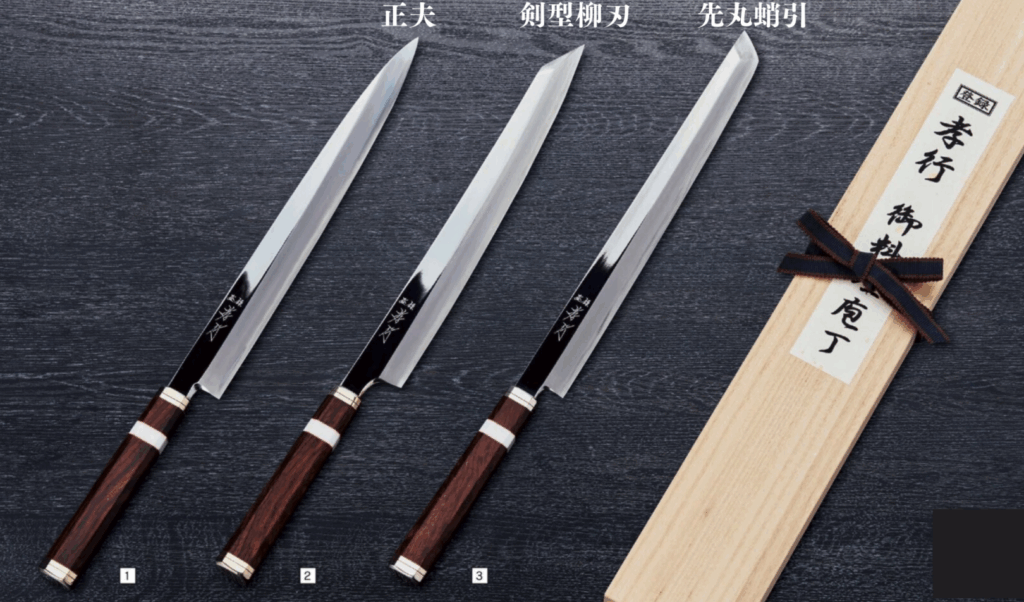
(Available in various shapes: standard Yanagiba, Kiritsuke Yanagiba, and Sakimaru Takobiki)
| Aspect & 5-Point Rating | Notes & Key Points |
|---|---|
| Sharpness ★★★★☆ | Gingami No.3 (Silver #3) stainless core is hardened and ground to carbon-steel-like keenness. The mirror-polished blade lowers surface friction, so it slices cleanly without crushing fibers—cut quality rivals White-steel yanagibas. |
| Edge Retention ★★★★☆ | Hammer-forged Silver #3 (~HRC 59–62) offers strong wear resistance. The edge holds up through full-day fish prep with virtually no chipping or noticeable dulling, minimizing mid-shift touch-ups. |
| Rust Resistance ★★★★★ | Full stainless construction plus mirror polish = maximum corrosion protection. Even if the blade stays damp during service, orange rust won’t appear—letting you focus on work instead of constant wiping. |
| Maintenance ★★★☆☆ | Daily care is “rinse and wipe.” For sharpening, Ginsan’s fine micro-structure means it regains a razor edge quickly on quality medium-to-fine stones, though the high hardness does require a bit of patience. Overall, very sharpener-friendly for a hard stainless. |
| Aesthetics ★★★★★ | Mirror-shined blade paired with richly grained Desert Ironwood handle exudes luxury; flawless fit and finish make the Shiden both a high-performance tool and a showpiece. |
| Price | Standard Yanagiba: 240 mm USD1150 270 mm USD1200 300 mm USD 1350 330 mm USD 1500 Kiritsuke Yanagiba 270 mm USD1350 300 mm USD1480 Sakimaru Takobiki 270 mm USD1350 300 mm USD1500 |
The Sakai Takayuki “Shiden” series is crafted with Gingami No.3 (Silver #3) – a high-end stainless steel developed by Hitachi Metals as part of the Yasugi family (the same lineage as the famous Blue and White carbon steels, but formulated to be stainless).
Silver #3 was created to mimic the edge qualities of carbon steel in a stainless alloy. It’s basically one of the closest stainless equivalents to the “feel” of carbon steel: it can take an extremely sharp edge and hold it well, and it has added chromium for rust resistance.
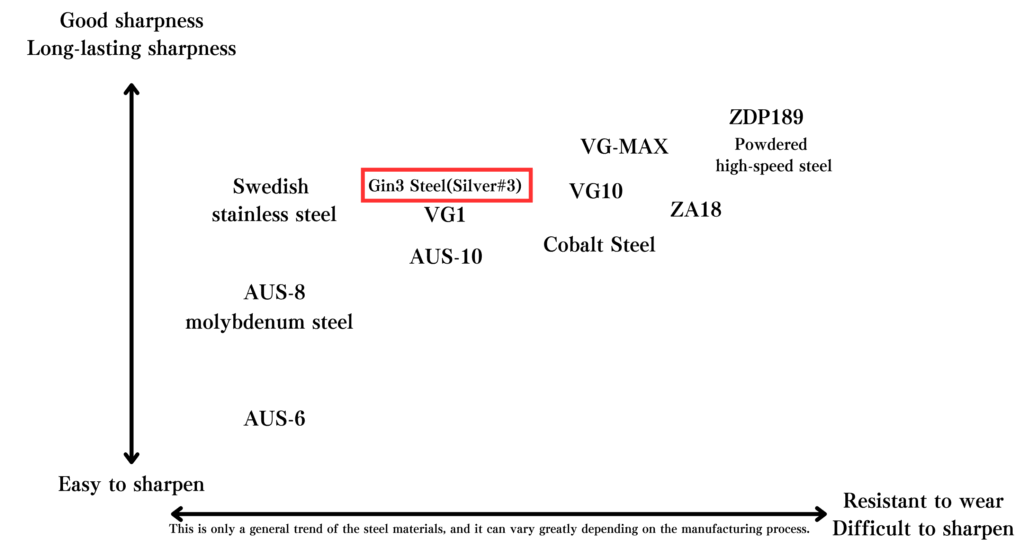
In the knife world, Ginsan is often called “the stainless steel that’s most like carbon steel.” Chefs love it because you get that ultra-sharp edge and long-lasting tip, without the constant worry about rust.
In practice, Silver #3 stainless (Ginsan-ko) has a balanced composition – enough chromium to fight rust and yet a high carbon content to achieve hardness around HRC 60.
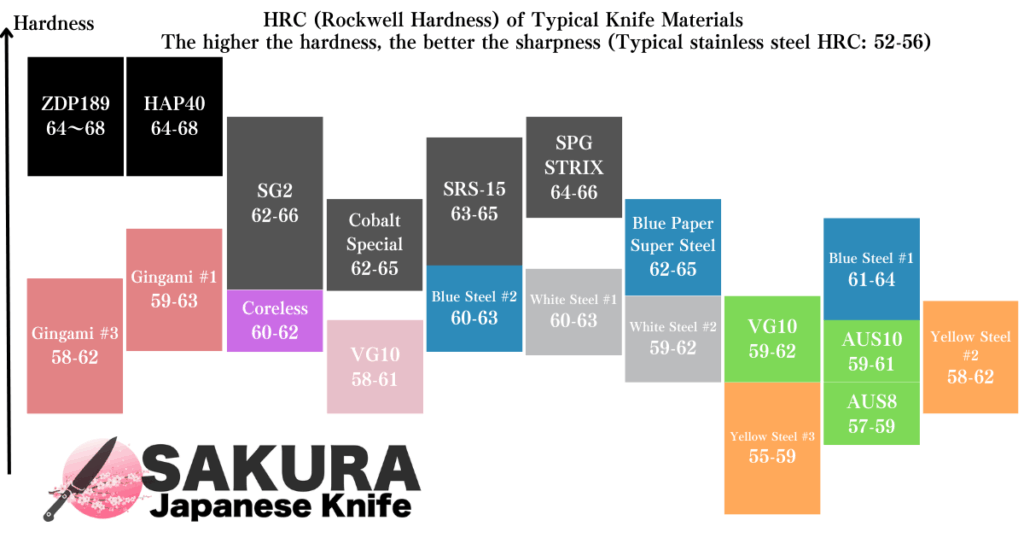
It forges well, meaning Sakai Takayuki’s blacksmiths can hammer and heat treat it to have an excellent refined grain structure. Properly hardened, it reaches around HRC 60 (give or take), which is high hardness, giving it great edge retention and still relatively easy maintenance at a high level. Many pros find that a Ginsan knife lets them “have it all” – sharpness, durability, and ease of care.
The Shiden series is also polished to a meticulous mirror finish through a multi-step process (from coarse grinding to fine stones to buffing) that removes virtually all scratches, leaving the blade face extremely smooth and reflective. This high polish not only looks stunning, it actually has functional benefits: it reduces drag through ingredients and helps the blade shed water and fish proteins more easily, which further enhances cutting feel and rust resistance.
The handles on Shiden knives are also something special. They use premium woods (e.g. Desert Ironwood or sometimes Mahogany) with a resin stabilization or oil finish, giving a deep glow and making them very durable. The combination of the shimmering blade and the beautifully figured wooden handle makes the Shiden series stand out as an “artisanal yet modern” piece. The overall vibe is a fusion of the solemn aura of a traditional wa-knife and the convenience of stainless steel – truly aimed at chefs who demand performance in sharpness, durability, and appearance.
The Shiden series offers multiple blade shape options, each with its own merits:
| Shape | Features | Merits (What it’s best at) |
|---|---|---|
| Shiden Standard Yanagiba (Syōbu)(正夫) | Traditional yanagiba shape with a sharply pointed tip. | Allows classic pull cuts to fully sever fish in one stroke. Very versatile – great for thinly slicing white fish (usuzukuri) and all-around sashimi work. |
| Shiden Kiritsuke Yanagiba (切付) | Kiritsuke (K-tip) style yanagiba with a clipped, angled tip and a sleek, sharp-edged design. | The blade exits the cut very smoothly (the clipped tip doesn’t snag). You can make paper-thin slices without the tip catching, resulting in immaculate sashimi slices end-to-end. The flat, aggressive tip is also excellent for fine decorative cuts and precision work. |
| Shiden Sakimaru Takobiki (タコ引き) | A takobiki-style blade (usually flat-tipped) but here with a gentle rounded tip (sakimaru). Essentially a yanagiba with a rounded end. | The rounded tip lifts off the cutting board easily at the end of a slice, keeping slices uniform and intact. It’s easier to handle safely (no sharp point) and is very user-friendly for long draw cuts – perfect, even slices with a smooth finish. Also reduces risk of poking or catching, and is forgiving for beginners to the yanagiba style. |
Professional Review – Washoku Chef (uses Shiden Kiritsuke Yanagiba): “I’m a devoted user of the Shiden Kiritsuke Yanagiba, and that angular kiritsuke tip has proven incredibly useful. For example, when plating fugu or tai usuzukuri on a large dish, having the tip slide out of the cut at the very end without any snag means each transparent slice remains perfectly intact, with no break in the cut surface. And the appearance – a long, razor-sharp blade that looks like a Japanese sword – is stunning. It also handles garnishing and fine knife work with ease; I often find myself marveling, ‘I can’t believe a sashimi knife can be so versatile!’ Plus, since it’s made of Silver #3, I don’t have to worry about rust at all – a huge benefit during hectic banquet prep. Even if I leave the blade a bit wet in the rush before service, a quick wipe with a damp cloth is enough; I don’t have to constantly fret. The transparency and sheen of the slices it produces are so beautiful even I’m in awe, and its edge sings a pleasant “suu” on the stone, a sign of a finely tuned blade. It truly fuses the best of traditional wa-knife excellence with the comfort of stainless steel – I can use it from morning prep straight through evening service without any stress. I’m proud to show it off as my trusty partner in front of customers – it’s a knife I can present with confidence as ‘my blade.’”
Professional Review – Sushi Chef: “The Shiden syōbu (standard) yanagiba makes a remarkable impression – it feels like a perfect blend of traditional yanagiba shape and modern stainless steel performance. The first thing I notice when gripping it is that it cuts with a sharpness uncharacteristic of a stainless knife. When I slice through maguro or hirame, the blade feels like it’s suctioned to the fish, with absolutely no resistance – it’s completely stress-free. The mirror finish blade repels fish oil, so after a cut the slice doesn’t stick to the blade at all, which is incredibly satisfying. And since it’s stainless, during a busy lunch service I can leave it aside damp for a few minutes without panicking about rust – it lets me save time on maintenance in those rush moments. From morning prep to night service, the edge barely dulls; it easily lasts the whole day, and then I just give it a light sharpen at night and it’s back to perfection the next morning. It’s hard to overstate how much easier this makes life – a knife that stays sharp and doesn’t rust means I can focus more on my work and less on the knife. Honestly, it holds an edge so well I rarely worry about it during the day, and with a quick touch-up at night it’s ready to go.”
4th Place: Izumimasa Aogami Super Honyaki Yanagiba 270 mm
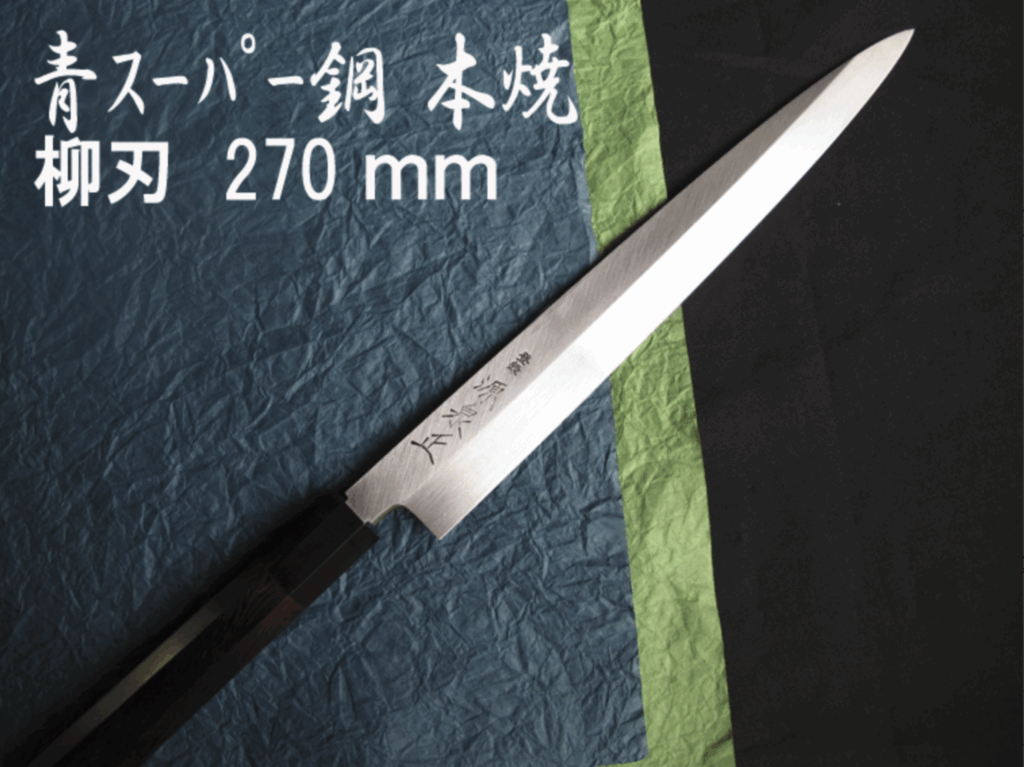
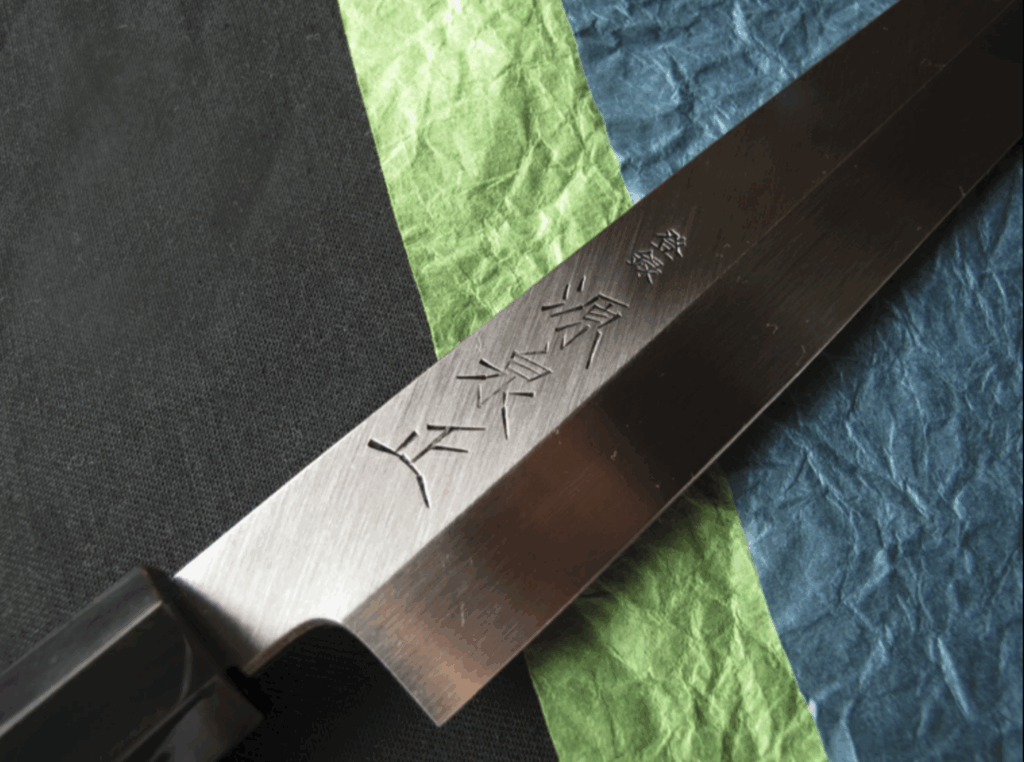
| Aspect & 5-Point Rating | Notes & Key Points |
|---|---|
| Sharpness ★★★★★ | Aogami Super honyaki blade ground to an ultra-acute edge feels “like cutting air.” Even tough silver skin parts with a gentle pull, delivering phenomenal, almost excessive keenness. |
| Edge Retention ★★★★★ | High-alloy Aogami Super (~HRC 66–67) is extremely wear-resistant; the razor edge endures dozens of fish with virtually no loss, so sharpening sessions are rare. |
| Rust Resistance ★☆☆☆☆ | Full high-carbon monosteel means very low corrosion resistance. Any moisture or salt left on the blade causes rust—immediate drying (and oil for storage) is mandatory. |
| Maintenance ★★☆☆☆ | Edge lasts a long time, but when sharpening is required the very hard honyaki steel demands diamond/ceramic stones and skilled technique—best for experienced sharpeners. |
| Aesthetics ★★★★★ | Mirror-polished honyaki blade shows a ghostly hamon; octagonal ebony handle with buffalo-horn ferrule creates a heirloom-level, sword-like presence. |
| Price | USD1,800 |
Izumimasa (泉正, read Izumimasa) is a brand of Matsuo Hamono in Sakai, a venerable maker. This particular knife is a honyaki yanagiba forged from Aogami Super steel – meaning it’s made of a single piece of the highest-grade Blue Super steel, without soft layers. Honyaki knives are the pinnacle of traditional Japanese knifemaking, akin to forging a sword; they are very hard, have a visible hamon (temper line), and require great skill to make and to maintain.
At 270 mm, this knife is sized for professional use. The blade is meticulously mirror-polished by hand, revealing a beautiful hamon pattern along the edge – a wavy line that can appear like a mist or faint clouds on the blade, unique to each piece. This hamon is created by differential hardening (like with samurai swords), giving the edge extreme hardness while leaving the spine slightly “softer” (though still very hard by normal standards). The overall vibe is that of a classic, top-of-the-line wa-bocho with a stunning visual presence and aura of tradition.
It’s often said in the industry that steels as hard as Aogami Super are “not suited to mirror finish” because they are so difficult to polish, yet Izumimasa’s craftsmen have achieved exactly that with advanced polishing techniques – a testament to their skill.
Aogami Super (Blue Super) is the top grade in Hitachi’s Blue Paper series – it’s two steps above Blue #2 in terms of carbon/alloy content and hardness potential. It boasts the highest hardness (around HRC 67±1 in this knife) among commonly used knife steels.

This translates to extremely low wear: the edge wears so slowly that chefs say things like “the knife hardly wears down,” “it keeps cutting forever,” and “the sharpness is astonishing.” Each blade is individually heat-treated by traditional water quench (mizuyaki ire), then tempered, to achieve this high hardness and reveal the hamon.
Of course, with this hardness comes brittleness and maintenance demands: the blade must be cared for diligently to avoid rust or damage. Even a small rust spot on such a hard blade can cause a pit that’s hard to remove, and any chipping will require serious work on coarse (often diamond) stones to fix. Honyaki blades also require careful flattening of the back (uraoshi) and precise sharpening angle control; it’s not forgiving like a softer knife. This is why such knives are recommended for experienced chefs and sharpeners who appreciate the “romance” and performance of this steel despite the challenges.
The payoff for those challenges, however, is immense: unparalleled sharpness and edge life. Chefs who love Blue Super often rave about its “hard = sharp” character and the fact it carries a mystique no other steel quite has. It’s indeed a knife that can last a lifetime (an “isshō-mono”) if cared for – the price is very high, but many consider it a worthy investment for that ultimate performance and the intangible joy it brings.
Professional Review – Sushi Chef: “When I hold this knife, it’s as if I can feel a tension in the air around me – it’s that awe-inspiring. I tested it on a block of otoro (fatty tuna): as I drew the blade through while holding my breath, the cut appeared with almost no sense of friction. Even the faint sound of the knife hitting the cutting board was clear and bell-like; the sharpness has been described as ‘cutting through water,’ and it truly sent a chill up my spine. The satisfaction when I can pull perfect slices one after another – each piece of fish cut to the ideal thickness for nigiri – is beyond compare. This knife makes that possible, and the sensation is exhilarating.”
Professional Review – Japanese Cuisine Chef: “When I use this knife for elaborate sashimi platters or when doing katsuramuki (thin sheet slicing) on daikon radish, it performs at the highest level. For instance, if I bring this knife out in its paulownia wood box at a celebratory event and proceed to slice a live carp for ikezukuri, the entire room falls silent just watching the knife’s presence and my movements. The hamon glimmering on the blade looks like the reflection of the moon on water, and with each cut, it’s as if a beautiful pattern is imprinted on the fish flesh. Handling it is nerve-wracking – this knife leaves zero room for error, which in turn sharpens my own senses as a head chef. Yes, it’s a constant battle against rust and chips and a trial in sharpening skill – but the sashimi it produces is extraordinary. When I lay out fugu usuzukuri (paper-thin pufferfish) with this knife, the transparent slices practically glow, and I often hear gasps of admiration from customers. It demands so much in care and skill, but it gives back an unparalleled cutting experience and results.”
5th Place: Sakai Ichimonji Mitsuhide White Steel #2 Kasumi Yanagiba
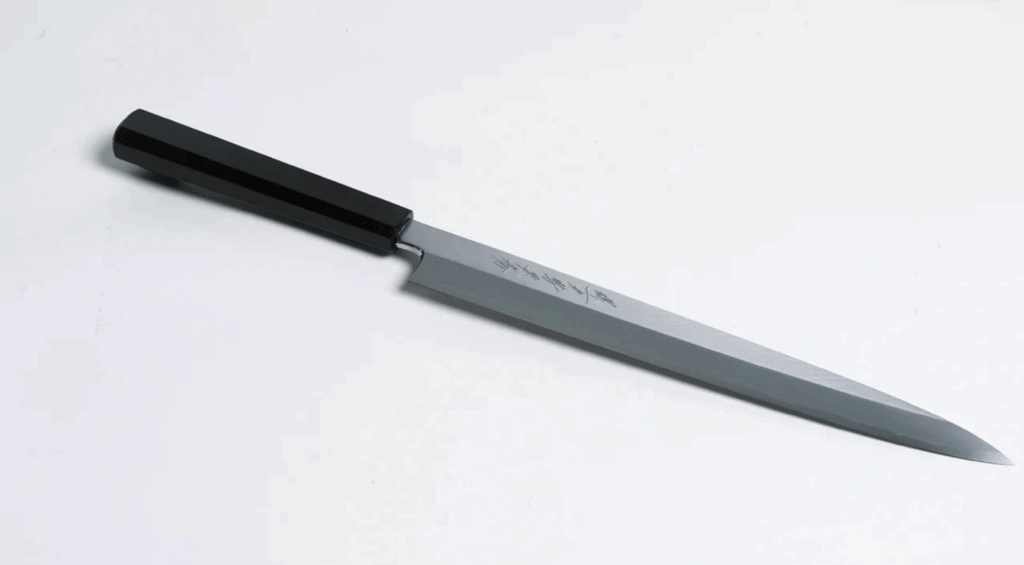
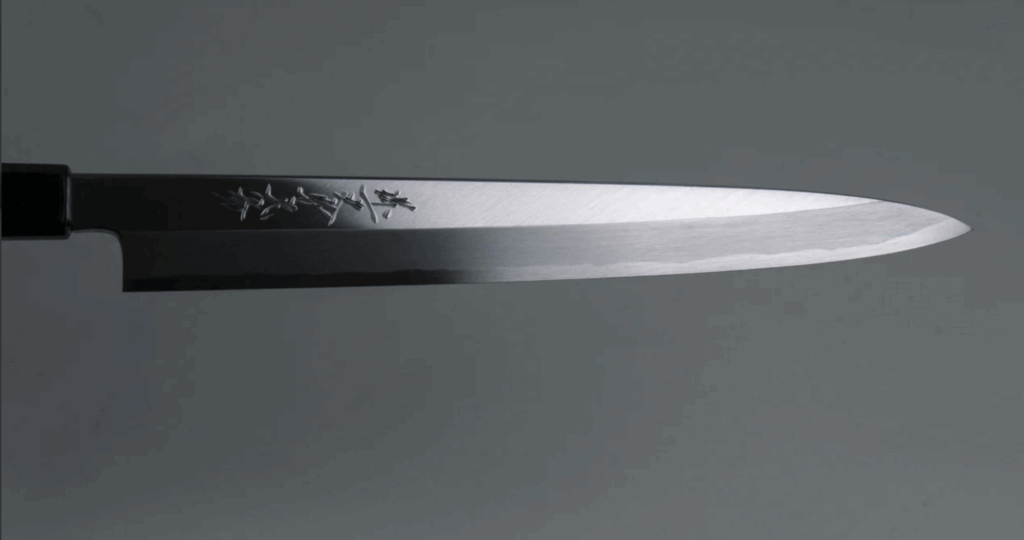
| Aspect & 5-Point Rating | Notes & Key Points |
|---|---|
| Sharpness ★★★★★ | White #2’s ultra-fine grain takes a mirror-like edge; Ichimonji Mitsuhide’s precise finish yields silky-smooth sashimi cuts that pull through in one stroke, enhancing mouthfeel and visual gloss. |
| Edge Retention ★★★☆☆ | Kasumi (soft-iron-clad) construction adds toughness, so chipping is rare. Edge life is shorter than Blue steel but dulling is gradual; light resharpening quickly restores razor keenness—some say it even gets sharper with repeated sharpening. |
| Rust Resistance ★☆☆☆☆ | Both core and cladding are high-carbon, so corrosion risk is high. Prompt washing and thorough drying are mandatory; patina is normal but red rust must be prevented. |
| Maintenance ★★★★☆ | White #2 is famously easy to sharpen—steel comes off smoothly and a crisp edge returns fast. Soft iron cladding gives good feedback on the stone, making this knife ideal even for sharpening apprentices. |
| Aesthetics ★★★★★ | Subtle kasumi contrast between hard steel and misty soft iron radiates traditional elegance. Magnolia handle with buffalo-horn ferrule completes the timeless, understated look; patina adds wabi-sabi charm over time. |
| Price | USD500 for 270 mm |
This yanagiba is made by Sakai Ichimonji Mitsuhide, a prestigious traditional brand from Sakai, Osaka. It’s a classic yanagiba using White Paper #2 steel (shirogami #2) for the edge and finished in the traditional kasumi method (where the hard edge steel and soft iron cladding are polished to create a hazy contrast).
Kasumi finishing brings out that “mist” pattern – a white haze – along the blade where the two metals meet, showcasing the craftsmanship.
The knife uses the same White #2 steel as the “Gion Haku” (#2 on our list), meaning it shares that highly valued sharpness and ease of sharpening.
Many sushi and washoku chefs start their careers with a White #2 yanagiba because it’s often said “begin with a White #2 yanagiba” – it’s sort of an ideal introductory high-end knife. It’s sharp, relatively easy to care for in the sense of sharpening, and not astronomically priced compared to honyaki or fancy alloy knives. This makes it a popular “first real yanagiba” for apprentice chefs and is widely used even by seasoned pros as a workhorse.
With this knife, you get that very sharp cutting performance expected of White steel – it pulls through fish like nothing. And because White #2 sharpens so well, many chefs actually sharpen their White steel yanagiba daily or every evening, enjoying the ritual and the ever-improving edge. The saying that “White steel gets sharper each time you sharpen it” is based on how the edge can be refined more and more as you master sharpening it.
Another highlight: Ichimonji Mitsuhide’s version comes with a wooden saya (sheath) included. (Unlike some brands like Jikkō where you pay extra for engraving your name, Ichimonji’s package includes a fitted wooden sheath by default – a nice bonus for safekeeping the knife.)

In use, the White #2 blade is extremely sharp and slices fish flesh smoothly, preserving the beautiful texture and appearance of sashimi. Because the edge “bites” so well (White steel has great cutting feedback), you can make very thin slices or intricate cuts with precision. It’s also fairly forgiving to sharpen incorrectly; if you happen to slightly alter your angle or pressure, White steel won’t punish you as severely as something like a honyaki Blue Super might. This makes it ideal for someone honing their sharpening skills.
The trade-off is maintenance: you do need to dry it immediately after use and be careful with acids. But that’s true of all carbon steel knives. If you put in the care – washing, drying, maybe a little oil now and then – this knife will serve you for many years and gradually form a protective patina that actually makes it a bit less reactive over time.
Performance-wise, it’s more than enough for professional use. It has the feel and balance of a proper Sakai-made yanagiba (usually a tad blade-heavy which helps in slicing). And importantly, it’s affordable enough that many pros can have one or two of these as daily drivers, whereas something like a honyaki might be brought out only for special tasks.
All in all, the Sakai Ichimonji Mitsuhide White #2 yanagiba offers a combination of razor sharpness, ease of sharpening, classic aesthetics, and reasonable price that make it a beloved choice. It’s often said, “if you’re not sure which yanagiba to get, you can’t go wrong starting with a good White #2 one” – and this knife embodies that sentiment.
Professional Review – Sushi Chef: “It’s no exaggeration to say that nearly every sushi bar’s cutting station has at least one Ichimonji Mitsuhide yanagiba. I’ve been using mine since my apprenticeship, and now it feels like an extension of my hand – a true partner. It has just the right weight and length, allowing me to do everything from ultra-thin kobujime hirame (kelp-cured flounder) slices to thick-cut hamachi sashimi with ease. A freshly sharpened White #2 edge is thin like a leaf and slices through fish with a satisfying ‘saku’ feeling. Every night after service, I diligently resharpen the blade, and since White steel is so easy to sharpen, it’s not tiring at all – each time I sharpen, the edge comes back mirror-like. This nightly ritual ensures I always start the next day with a perfect edge.”
Professional Review – Washoku Chef: “This yanagiba is as classic as it gets – a staple in the Japanese kitchen. It has no quirks and an orthodox shape, so I even use it for tasks beyond sashimi: I’ll peel vegetables (like using it as a usuba for katsuramuki in a pinch) or slice grilled fish like a sujihiki. But above all, the distinct razor sharpness and easy sharpening of White steel are major assets in a busy kitchen. That sharp edge is a weapon for me during hectic prep – it cuts beautifully and I can always quickly resharpen if needed. The only caveat is its tendency to rust, but as long as I properly clean and dry it after use, it’s no issue. This is a knife I can form a long relationship with. It has that dignified presence of a traditional wa-bocho, and the plain ho-wood handle with buffalo horn collar feels better and better in the hand the more I use it – it really grows on you with time. In the professional Japanese kitchen, many even say ‘start with a White #2 yanagiba,’ and I agree – it’s an excellent knife to accompany you through your career. Just be mindful of the long blade and sharp edge – it requires some getting used to in handling, particularly the slight blade curvature (warp) and thin tip that are inherent to single-bevel knives, meaning if you sharpen it incorrectly you could lose sharpness or chip it. And of course, it will rust if neglected, so you have to stay on top of cleaning and drying. But that’s true of all wa-knives. Overall, it’s a reliable knife you can stick with for the long haul.”
6th Place: KAI Seki Magoroku Aogami #2 Yanagiba

| Aspect & 5-Point Rating | Notes & Key Points |
|---|---|
| Sharpness ★★★★☆ | Blue Paper #2 core is sharpened by KAI’s veteran craftsmen to an “exquisite sharp yet smooth” edge that rivals White #2. It glides through delicate fish as if the blade is being “sucked in,” leaving flawless, fiber-free cuts. |
| Edge Retention ★★★★☆ | At ~HRC 62, alloy elements (W, Cr) give Blue #2 superior wear resistance, so the keen edge endures long prep sessions with minimal touch-ups—ideal for chefs working extended hours. |
| Rust Resistance ★★☆☆☆ | Still carbon steel, so it will rust if left wet. The small chromium content slows oxidation slightly and a dark patina can build protective character, but diligent wipe-and-dry habits remain essential. |
| Maintenance ★★★☆☆ | Blue #2 sharpens smoothly on quality stones—just a bit slower and with heavier feedback than White #2. Edge lasts longer, so sharpening frequency is lower, but daily cleaning/drying is mandatory. |
| Aesthetics ★★★★★ | Refined satin kasumi finish with subtle wave pattern and faint jigane grain; buffalo-horn ferrule and the storied “天下の関孫六” engraving lend understated luxury and heritage. |
| Price | USD770 for 270 mm |
This knife comes from KAI’s famous Seki Magoroku line – KAI is the company known for Shun, etc., but in Japan their Seki Magoroku series has a long history. This particular yanagiba uses Blue Paper #2 steel (Aogami #2) as its core. It’s a fusion of traditional techniques with KAI’s modern quality control.
Blue #2 is White #2 steel with tungsten and a bit of chromium added. The result is a steel that’s harder and holds an edge longer. As mentioned, KAI’s implementation of Aogami #2 in this knife aims to combine traditional performance with improved durability.
According to Hitachi’s data (which KAI would follow), Blue #2’s alloying elements increase toughness (less chipping) and “nagagire” (edge retention, literally “long-cutting”). It basically addresses the main drawback of White steel (shorter edge life and tricky heat treatment) by being easier to heat-treat and staying sharp longer.
The Seki Magoroku Blue #2 Yanagiba exemplifies this. Chefs who use it often say it retains the crispness of its edge through long prep sessions. For instance, a chef who has to slice fish all day finds that they don’t need to sharpen midday – the knife keeps performing. That can be a huge advantage in a busy restaurant where pausing to hone knives isn’t always possible.
KAI’s craftsmanship is evident as well: this knife is well-finished, with even blade geometry and a nicely installed handle. The buffalo horn ferrule on the handle is a mark of a higher-end product (cheaper ones often use plastic ferrules). The buffalo horn on each knife has its own marbling pattern – a subtle aesthetic plus.
Being a product of a big company like KAI, you also get the reliability of manufacturing – consistent hardness, good fit and finish, and warranty support if needed. Some professionals trust such established brands for work knives because they know exactly what they’re getting.
The engraving of “関孫六” (Seki Magoroku) on the blade is historically significant – it refers to Magoroku, a famed swordsmith of Seki, and has become a trademark of quality cutlery from that region. So it carries a bit of heritage.
In terms of construction, it’s a kasumi knife: hard Blue #2 steel jacketed in soft iron. That means it’s not full stainless, but the performance is top priority.
As a result, everyday use requires the same care as other carbon steel knives. If you’re working with vinegared rice or slicing citrus garnishes, you’ll want to rinse the blade after those tasks to avoid patina or rust. But Blue #2’s slightly higher corrosion resistance means it’s just a hair more forgiving.
Given its price, this knife is positioned as a high-quality option for professionals who want Blue steel performance without going into super high-end territory. It provides a great balance of performance, appearance, and value.
Professional Review – Tokyo Sushi Chef: “This Blue steel yanagiba by KAI is impressive – even if I use it continuously all evening for sashimi, the edge holds astonishingly well. In a busy sushi restaurant, I don’t have time to resharpen during service, so this really helps. The sharpness is superb, letting me pull through everything from delicate white fish to fattier otoro smoothly. On the stone, it feels a bit harder than White steel, but in return, once I sharpen it properly, I know it will last through the whole day and then some. I love that I can just give it a good sharpening after we close, and I’m confident it’ll stay razor sharp through the next day’s lunch rush and beyond. Also, while sharpening, I do sense it’s harder than White steel, but it’s manageable – just needs a bit more focus and using a coarse -> medium -> fine progression. The trade-off is absolutely worth it for the durability I get.”
Professional Review – Osaka Washoku Chef: “I truly appreciate this knife when preparing a large amount of sashimi for banquets. For example, when making sashimi platters for 50 people, I realized how grateful I was to have this blade – I hardly had to pause to touch up the edge at all. Of course, I still sharpen regularly, but during the actual work, the sharpness carries me through so I can focus on plating. Sharpening it does require a bit more ‘guts’ – it feels harder than White steel under the stone – so I take care to go through coarse, medium, fine stones properly. Once you get used to it, it’s like wielding a demon-slaying sword (oni ni kanabō, literally ‘an invincible weapon’) – in a busy catering environment it’s a very reliable partner.”
7th Place: Sakon “Ryuga” Single-Bevel Yanagiba (SRS15 Powder Steel)

| Aspect & 5-Point Rating | Notes & Key Points |
|---|---|
| Sharpness ★★★★★ | Powder-metallurgy SRS15 steel has a fine microstructure that takes an exceptionally acute single-bevel edge. Pros call it “unbelievably sharp,” slicing sashimi (and even firm skin) with a smooth, effortless pull. |
| Edge Retention ★★★★☆ | SRS15’s extreme wear resistance lets the razor edge last through a full day of heavy prep with little drop-off—ideal for busy pro kitchens that need long-lasting keenness. |
| Rust Resistance ★★★★★ | With ~15 % chromium, the stainless PM steel is highly corrosion-proof; normal washing/drying is enough, so no constant wiping worries during service. |
| Maintenance ★★☆☆☆ | Daily care is easy and sharpening is infrequent, but when sharpening is required the very hard (~HRC 64) alloy-rich steel grinds slowly; diamond/ceramic stones and patience are advised. |
| Aesthetics ★★★★☆ | Subtle kasumi-style blade finish with a clean, professional look; dark stabilized octagonal handle offers rich grain and a “stealth wealth” vibe—quietly refined rather than flashy. |
| Price | ¥80,041 (税込) for 300 mm — approximately $800 USD |
This Sakon “Ryuga” yanagiba is part of the premium line by Sakon, a knife brand from Tosa (Kochi Prefecture). It marries traditional Japanese knife design with a state-of-the-art powder metallurgy steel (SRS15). This makes it a very innovative piece: essentially a traditional yanagiba made with ultra-modern steel technology.
SRS15 is a powdered high-speed tool steel. High-speed steels are known for cutting metal at high temperatures (in industry) and generally have high hardness and wear resistance. Being powdered means the steel’s components are evenly distributed, leading to a very fine grain and homogeneous structure. SRS15 has around 15% chromium (hence stainless), and is hardened to about HRC 64. So you get a very hard edge, like a carbon steel, but with stainless properties – the best of both worlds in many respects.
The official descriptions say things like “achieves astonishing sharpness and high corrosion resistance” – which is evidenced by professional feedback. Many chefs who prefer stainless often sacrifice a bit of sharpness, but with this knife they don’t have to – it cuts like a top carbon steel knife and doesn’t rust.
The blade is made by roll forging – likely a process where a steel billet is pressed and extended. It’s a three-layer cladded blade: a core of SRS13 (very similar to SRS15, maybe a slightly different spec) sandwiched between SUS405 stainless on both sides. The SUS405 cladding is soft stainless steel, which protects against rust and adds toughness. So it’s a stainless clad stainless – completely rust-resistant structure, but still retains a Japanese knife geometry.
Because of the cladding, the knife has a kasumi finish akin to a traditional knife. The soft stainless cladding is given a hairline matte finish, contrasting with the shiny core steel at the edge. They’ve also done a light tsuchime (hammered) texture on the blade flats, which is more than just decorative: those small dimples help food release and prevent water from sticking.
The handle is octagonal and made from wood that has been resin-impregnated (stabilized) – likely a dark hardwood or layered bamboo as mentioned in some descriptions. Stabilized wood is great for durability – it won’t shrink or rot, and it has a nice polished look. The handle likely uses an impregnated dark wood or multi-layer bamboo, and it has a buffalo horn ferrule (dark brown/black). So high-end materials all around.
Sakon marketed the Ryuga as “an ambitious piece using the latest powdered high-speed steel in a traditional wa-knife”. The official line was that it achieves “amazing sharpness and high rust resistance” as stated by the maker. They note the core steel is SRS13 (which is basically same family as SRS15, minor differences in composition – likely they use SRS13 name but hardness around 64 indicates similar performance). They mention it reaches HRC 64 and above.
The claim is that because of the fine structure of the steel, even a very thin edge remains stable and unbelievably smooth in cutting – described like “slicing through silk”. Indeed, chefs have described the sensation as like “tearing silk” or “splitting fabric” – meaning extremely smooth.
For the cut quality, one chef described: “When the blade enters the fish, it’s as if it slices through like ripping silk – the lack of resistance is extraordinary.” This is due to the uniform microstructure enabling a very acute edge.
Since the blade is clad in stainless, the core steel is fully encased except at the edge – reducing maintenance and adding a bit of toughness to the thin blade. The knife is forged in a way (roll-forged) that presumably aligns the structure for strength.
Overall, the Sakon Ryuga is like the solution for chefs who want the ultimate performance but with far less maintenance fuss. It’s unbelievably sharp, stays that way, and doesn’t rust – basically a professional’s dream tool. The only slight drawback is sharpening difficulty, but given how rarely you need to sharpen, many feel it’s a worthy trade.
Professional Review – Kanazawa Sushi Chef: “This knife’s sharpness can only be likened to a Japanese sword. Even pulling it through a block of maguro, it slices straight to the end with zero effort – it’s awe-inspiring. The edge holds up so well that even on a busy night service, I almost never have to worry about it dulling; I’ve virtually never had to fret about the sharpness giving out mid-service. Granted, when sharpening, you do feel the hardness – but since I hardly need to sharpen it often, that’s not an issue. Yes, it was expensive, but I feel that thanks to this knife, my precision and speed have improved, and I’m able to provide my customers with the absolute best nigiri.”
Professional Review – Tokyo Washoku Chef: “I never imagined a rust-resistant yanagiba could be so comfortable to use. With traditional sashimi knives, you usually have to constantly wipe off moisture and oil the blade to prevent rust, but the Ryuga feels almost like using a stainless western knife in terms of care. Yet its cutting ability surpasses even traditional knives. Even after breaking down a large fish, the blade doesn’t waver, and it slices through sinewy parts with a smooth, clean cut. There is, of course, a certain tension in handling it – the knife itself demands precision and doesn’t forgive mistakes easily… It challenges your skill, especially in sharpening, as if it’s saying the tool is only as good as the craftsman. But precisely because of that, once you master it, you feel like you can perform at a higher level as head chef. It elevates your work.”
8th Place: Sakai Takayuki VG10 33-Layer Damascus Kiritsuke Yanagiba 270 mm (Mahogany Handle)
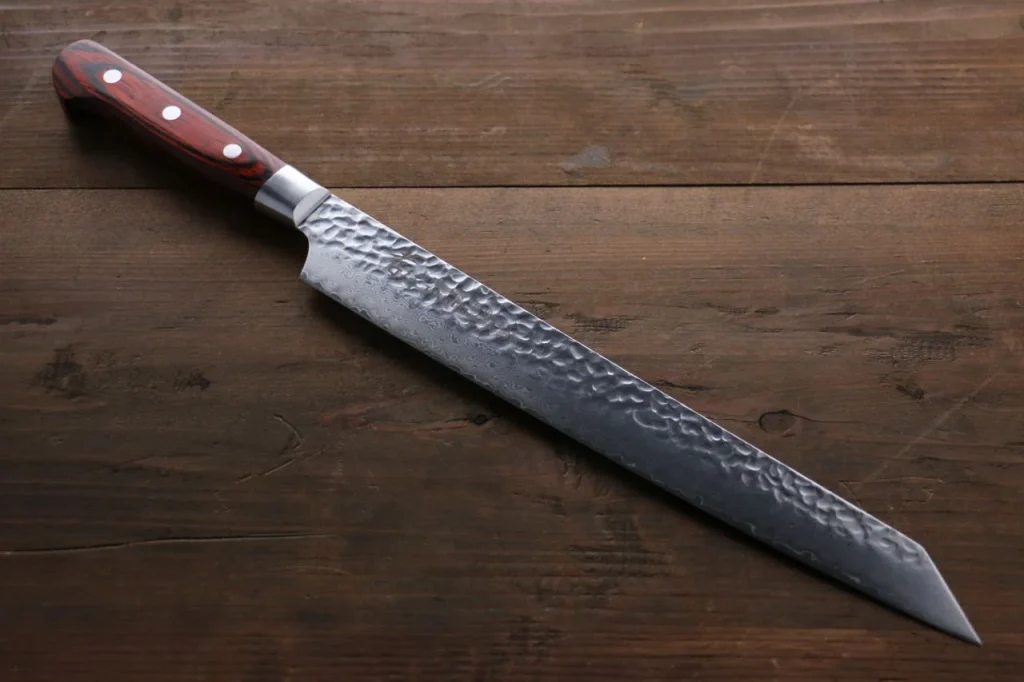
| Aspect & 5-Point Rating | Notes & Key Points |
|---|---|
| Sharpness ★★★★☆ | VG10 core hardened to low-60 HRC and finely honed by Sakai Takayuki yields paper-slicing sharpness out of the box. Double-bevel geometry offers stable control (even for left-handers) and produces clean, rag-free sashimi cuts. |
| Edge Retention ★★★★☆ | Alloy elements (Co, V) in VG10 plus ~HRC 60 hardness give long-lasting keenness. Users report processing dozens of portions with almost no decline—ideal for a full dinner service. |
| Rust Resistance ★★★★★ | Entire blade—VG10 core and 33-layer Damascus cladding—is stainless, so corrosion is a non-issue. Hammered tsuchime texture helps water bead off; normal wash-and-dry care suffices. |
| Maintenance ★★★☆☆ | Double-bevel edge sharpens like a normal chef’s knife—no single-bevel tricks required. VG10 is wear-resistant, so quality stones help, but upkeep is straightforward: occasional sharpening plus basic washing/drying. |
| Aesthetics ★★★★★ | 33-layer Damascus wave paired with hand-hammered finish creates shimmering visual depth, complemented by a warm mahogany handle—an artful showpiece as well as a tool. |
| Price | USD450 |
Sakai Takayuki’s 33-layer VG10 Damascus Kiritsuke Yanagiba is a mouthful of a name, but it perfectly describes this unique knife. It’s essentially a hybrid of Japanese styles: a yanagiba with a kiritsuke (K-tip) shape, but unlike most yanagibas, it’s double-edged. This makes it a kind of crossover knife that offers the aesthetics and slicing capability of a yanagiba with the ease of use of a Western knife.
The blade is constructed from a core of VG10 stainless steel, with 33 layers of alternating soft and hard stainless steels forged on each side (for a total of 33 layers). This layering creates the beautiful Damascus pattern – a flowing, watery pattern often in a herringbone or ladder-like design on the blade surface. On top of that, the blade has a tsuchime (hammered) finish. The hammer strikes leave small dimples that not only look appealing but also function to reduce sticking of food.
This knife is hardened to around HRC 60–61 (since VG10 can go that high), which is why it holds an edge well. Being double-beveled is unusual for a yanagiba – typically yanagiba are single-bevel (for right-handers). But by making it double-beveled, Sakai Takayuki made this knife accessible to a wider audience, including left-handed users and those not trained on single-bevel sharpening techniques. It’s essentially a long, slender slicer in the style of a yanagiba.
The kiritsuke tip (also called kensaki, a sword-like tip) gives it a distinctive look – a straight clipped tip rather than the usual pointed one. Many find kiritsuke tips visually striking (they resemble a samurai sword kissaki) and also practical: the flat angled tip can be used for intricate work and, as some chefs note, it can exit a cut smoothly when doing thin slices.
A notable aspect of this knife is that it’s part of Sakai Takayuki’s popular Damascus series. The craftsmanship is high: the Damascus pattern is even, the hammer marks are artfully done, and the entire blade has a consistent finish. They also mount a mahogany handle, which is a bit heavier and denser than the typical magnolia, giving a sense of luxury and balance to the knife.
The price (~$420 for 270mm) positions it as a premium knife but not out-of-reach like honyaki knives. It’s a fantastic option for someone who wants a high-performance sashimi/sushi knife but prefers stainless steel and ease of maintenance.
Because it’s stainless and double-edged, it’s actually a great choice for serious home cooks or Western-trained chefs who may not have the bandwidth for the upkeep of carbon steel single-bevel knives. It basically gives you 95% of what a traditional yanagiba can do, with only minor differences (e.g., single-bevel yanagiba might make even cleaner cuts in expert hands, but the difference is small).
The hammered Damascus aesthetic also makes it gift-worthy or display-worthy. It’s the kind of knife that often catches the eye in a knife store or chef’s roll.
The core steel VG10 is a well-regarded stainless cutlery steel – it’s used in many high-end Japanese knives for a reason: it’s a good balance of hardness, toughness, and corrosion resistance. It might not quite match the absolute sharpness or ease of sharpening of White #2, but it gets very close, and many find it more than sufficient for sashimi work while being far easier to maintain.
The hammered Damascus cladding does have one maintenance note: if over-sharpened or ground down a lot, you could in theory start to lose some of the Damascus pattern near the edge. But under normal use (taking many years to significantly wear down the knife), this isn’t a big concern. One just has to sharpen carefully to preserve the pattern – but since it’s full stainless, there’s no “cladding line” or iron layer to worry about, so it’s straightforward.
Professional Review – Sakai Craftsman Quote (from product description): “The 33-layer Damascus pattern combined with the hammered finish creates a blade face that shows different expressions depending on how the light hits it – it’s truly artistic. The fine herringbone Damascus and the glittering tsuchime make this knife a sight to behold.”
Customer Feedback – Sushi Enthusiast: “This knife is both functional and a work of art. The first thing that struck me was the mesmerizing Damascus pattern. In use, it’s incredibly sharp – I was able to fillet a large salmon and slice sashimi ultra-thin without any tearing. And as someone left-handed, the double-edge design was a big factor in choosing it (no awkward single-bevel handling). It also doesn’t rust, which for me, coming from using carbon knives, is a relief. After prepping sushi for a dinner party, cleaning up was just wash and dry – no stains at all. The edge held up through cutting fish, rolls, even some vegetables for garnish, with no noticeable dulling. It feels like a great fusion of East and West – a traditional shape but in a user-friendly format.”
9th Place: Sakai Jikkō “Ginsan” Sashimi Knife (Silver #3 Steel)


| Aspect & 5-Point Rating | Notes & Key Points |
|---|---|
| Sharpness ★★★★☆ | Silver #3 stainless takes an edge “not losing to White steel.” Out of the box it glides through fish with zero resistance, leaving pristine sashimi surfaces—ideal when a smooth pull-cut is critical. |
| Edge Retention ★★★★☆ | Properly heat-treated Ginsan (~HRC 59–62) holds keenness through dozens of fish with minimal dulling, so pros make fewer trips to the stones during long prep sessions. |
| Rust Resistance ★★★★★ | Fully stainless blade means corrosion worries virtually disappear. Even brief moisture exposure won’t spot; a quick rinse-and-dry keeps the mirror-kasumi surface spotless. |
| Maintenance ★★★☆☆ | Daily care = simple wash & dry. Ginsan sharpens almost like carbon steel—stone feedback is smooth and wear is moderate—so restoring the edge is stress-free, especially for wa-knife newcomers. |
| Aesthetics ★★★★★ | Traditional near-mirror kasumi finish, elegant profile, and blonde pakkawood (or ho-wood) handle with black buffalo horn ferrule create a classic, refined look worthy of a master sushi chef. |
| Price | 210 mm ¥30,800 / 240 mm ¥35,860 / 270 mm ¥43,120 / 300 mm ¥54,780 / 330 mm ¥65,230 / 360 mm ¥84,370 (税込) — roughly $308 / $359 / $431 / $548 / $652 / $844 USD |
This Sakai Jikkō “Ginsan” Sashimi Knife is a staple in the professional world. Sakai Jikkō (實光刃物) is a revered Sakai-based maker, and their Ginsan series is highly regarded. The core steel is Hitachi Gin3 (Silver #3) stainless steel – often just called “Ginsan” or “Ginsanko” – which offers carbon-steel-like performance with stainless properties.
This knife basically provides a solution for chefs who love the cut of carbon steel but want less upkeep. It’s widely supported by pros from sushi chefs to kaiseki chefs because it delivers on both fronts: sharpness and convenience. In fact, Jikkō often markets it as “perfect for those starting with wa-bocho maintenance” because it removes the intimidating rust aspect.
The brand Jikkō has over 100 years of history, inheriting Sakai’s 600+ years of knife-making tradition. Every knife is carefully finished with traditional methods. The Ginsan series is made with the same care as their carbon steel lines – the only difference is the steel itself.
They go through forging, heat treating, and grinding with the same standards. The final product has a lovely kasumi (mist) polish, giving a near-mirror shine on the edge and a cloudy finish on the flats. It looks every bit like a classic white steel yanagiba (some might not even realize it’s stainless at a glance).
Because Ginsan steel sharpens similarly to carbon, Jikkō often mentions that even if it does get a bit dull, you can sharpen it with a similar feeling as sharpening a shirogami blade – meaning, it’s approachable for people who might not be experts.
This makes it a very strong choice for a first high-end yanagiba: you get to practice and use a top-quality knife without the punishment of immediate rust if you slip up on maintenance.
In terms of performance, Ginsan is often called “the most carbon-like stainless.” It was literally designed to replicate the cutting feel of carbon steel in a stainless form. Many chefs confirm that – some actually switch to Ginsan knives for daily work because, as one said, “I get the same results as my carbon knife, but I don’t have to worry about rust all day.”
This knife, being from Jikkō, would have exceptional heat treatment – likely hitting around HRC 60 which is optimal for Ginsan. That hardness plus fine grain yields the top-tier sharpness.
Multiple sizes are available (as listed), making it versatile whether you need a small yanagiba for home use (210 mm) or a very long one for large fish (up to 360 mm!). Jikkō covers them all, so a chef can choose based on their needs.
Given that it’s a top-tier item, the price is reflective but still less than some carbon honyaki or brand-name Damascus pieces, making it actually a very reasonable investment for what you get.
In summary, the Sakai Jikkō Ginsan sashimi knife is a high-performance, low-maintenance tool that has earned trust across both professional and high-end home cooking spheres. It’s the kind of knife that becomes a long-term partner in the kitchen, offering reliability and excellence with fewer worries.
Professional Review – Edomae Sushi Chef: “I work as an Edomae sushi chef and use a variety of knives daily. My first impression when I held this Jikkō Ginsan yanagiba was how naturally it fit my hand – it felt like it just sucked into my grip with perfect balance. The first thing I did was slice a fresh slab of tuna that arrived that morning, and I was amazed at how smoothly the blade entered. By using the entire blade length from heel to tip in one motion, the tuna’s cross-section came out glossy as glass. The knife’s incredible sharpness meant it cut without crushing any cells, so the slice didn’t weep moisture and retained its luster. Thanks to that, the neta (fish topping) stays fresh longer and when placed on sushi rice, the aroma and texture of the fish are outstanding.”
Professional Review – Washoku Chef: “Working in a washoku kitchen, I use my sashimi knife not just for sashimi platters but for many tasks. Since introducing this Jikkō Ginsan sashimi knife, I’ve been saved by its versatility and ease of use. When slicing sashimi, its sharpness and length show their full power: for example, when preparing a kaiseki platter, I can make transparent usuzukuri slices of tai or hirame by simply laying the blade down and pulling it straight through – the Ginsan yanagiba produces slice after slice of paper-thin fish with ease. The tip is sharpened perfectly, making even delicate tasks like filleting the skin off a flounder remarkably easy – I just slide the blade between the skin and flesh and in one go, the skin comes off cleanly without waste. It’s really a multipurpose sashimi knife that I can rely on for any situation.”
Conclusion
In this article, we’ve presented our recommended sashimi knives separately for beginners and for professionals.
For beginners, it’s often best to focus on a knife that is easy to handle and maintain, yet still offers a decent level of sharpness. You’ll want a blade that’s rust-resistant and not too difficult to sharpen, so you can concentrate on improving your technique. In practice, a slightly shorter yanagiba (around 240 mm) with a user-friendly steel (stainless or stainless-clad) is an excellent starting point. Such a knife will still allow you to achieve clean cuts without overwhelming you in maintenance.
For professionals, since the presentation and taste can be directly affected by the knife’s performance, maximizing sharpness becomes crucial. It often makes sense to choose a knife with the highest quality edge your budget allows, as long as you can also keep up with its maintenance needs.
That often means a longer blade for larger fish and one made of a top-grade steel (whether carbon or high-end stainless) that will hold a razor edge. Among those, carbon steel yanagibas that can be maintained regularly (through daily sharpening and care) remain a popular choice for their ultimate cutting feel – provided you’re comfortable with the upkeep.
On the other hand, modern stainless options like Ginsan steel are a very strong choice too, offering near-carbon performance with easier care, which is a compelling option for many chefs.
Each of the knives in our rankings is a standout piece in its own right. Ultimately, the “best sashimi knife”, “best sushi knife”, or “best yanagiba knife” for you will depend on your specific needs – your typical fish sizes, your comfort with maintenance, and your personal preferences in balance and feel. We hope this guide has given you a clear overview of what to look for and introduced you to some of the top picks available, so you can choose a sashimi knife that will elevate your sushi and sashimi preparation to the next level. Enjoy your journey in mastering the art of slicing sashimi!

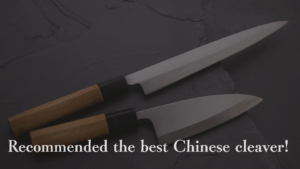
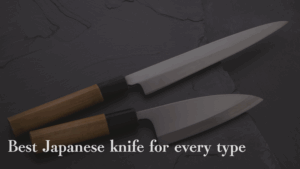
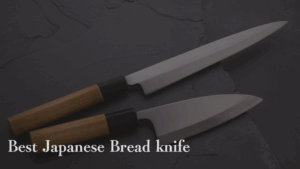
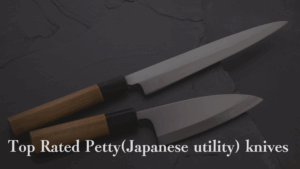

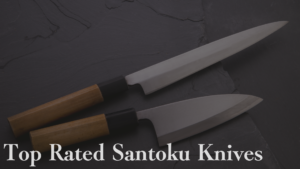
Comments